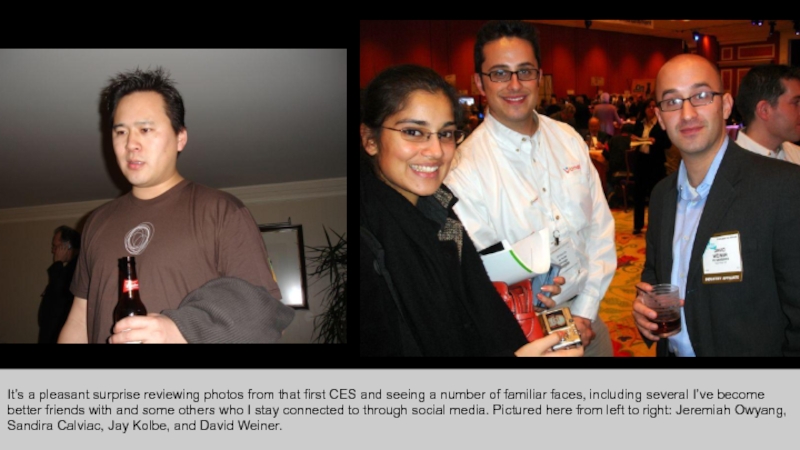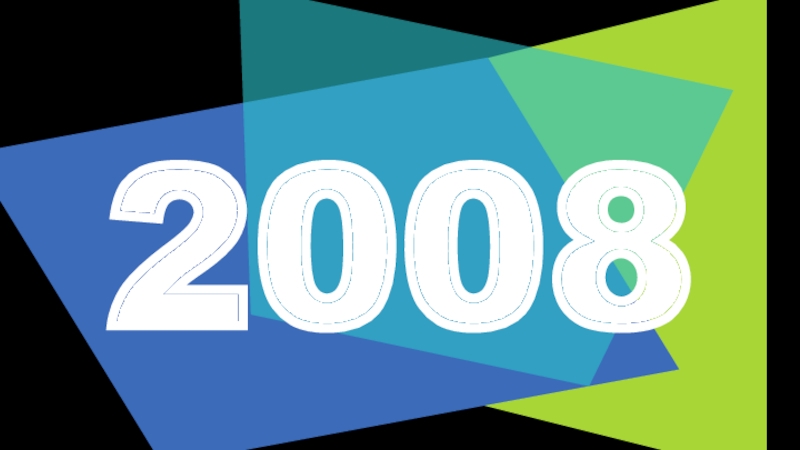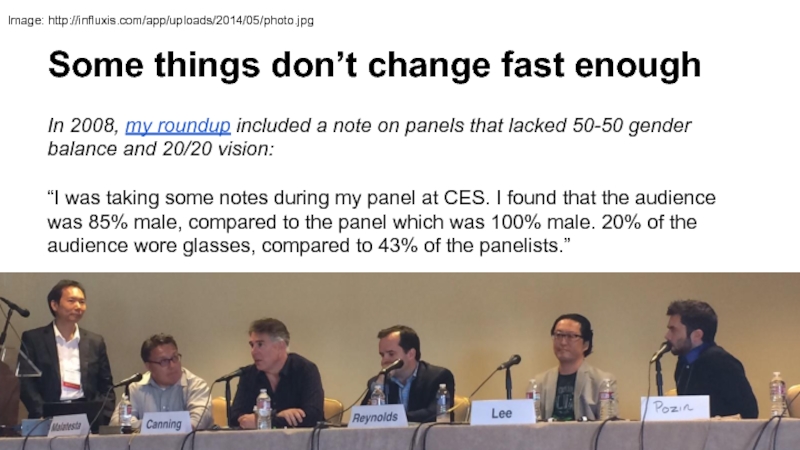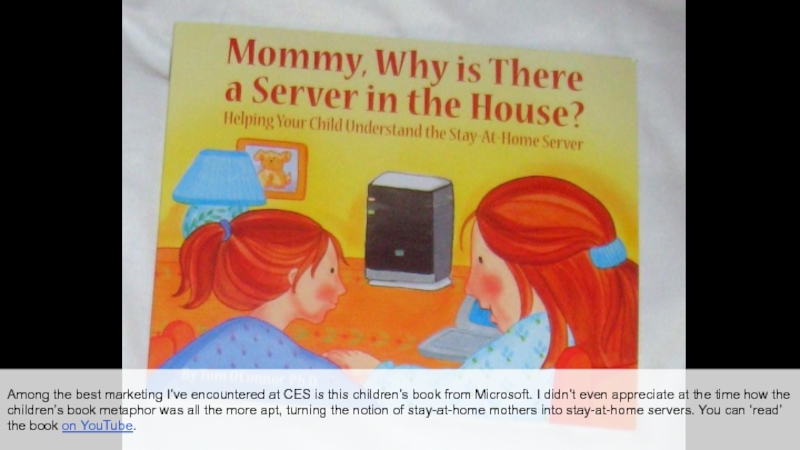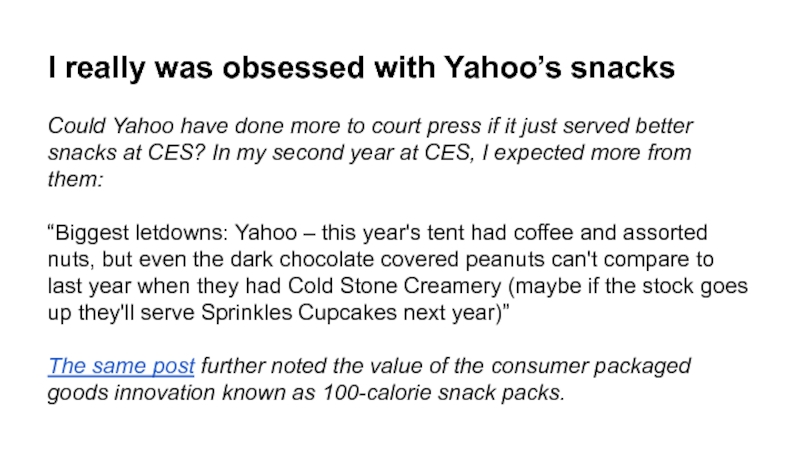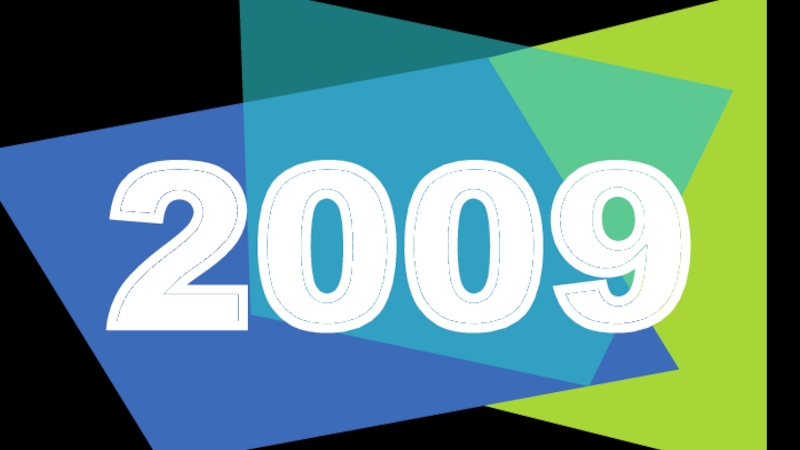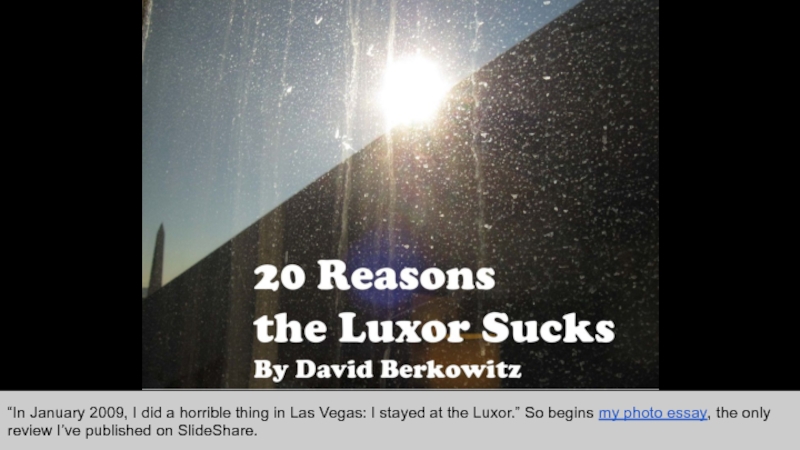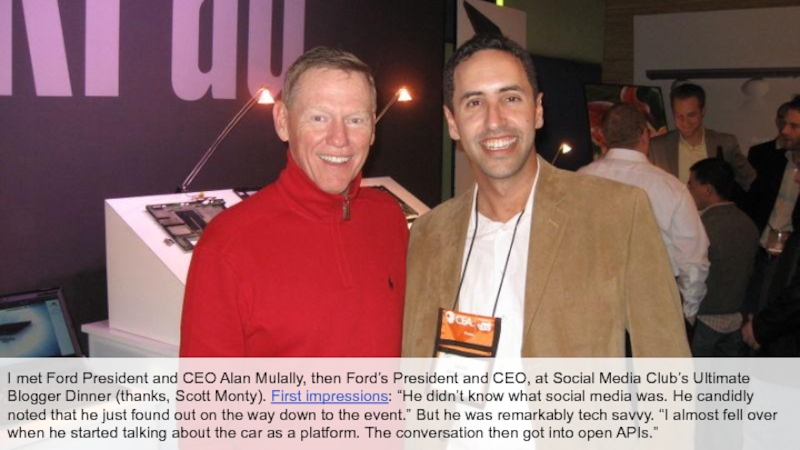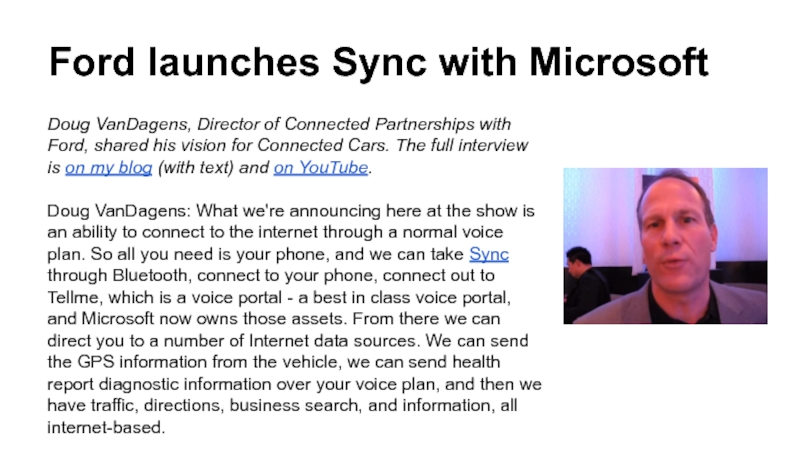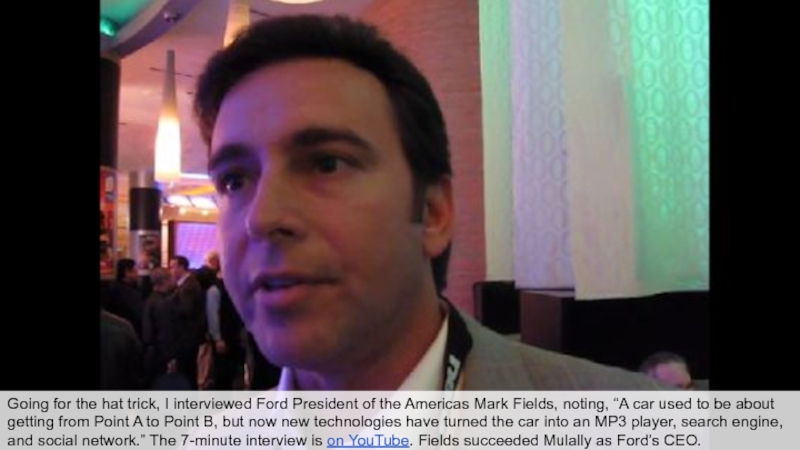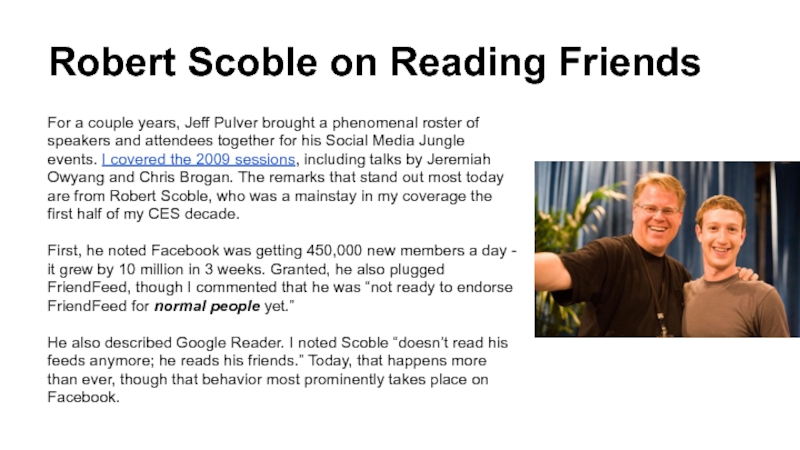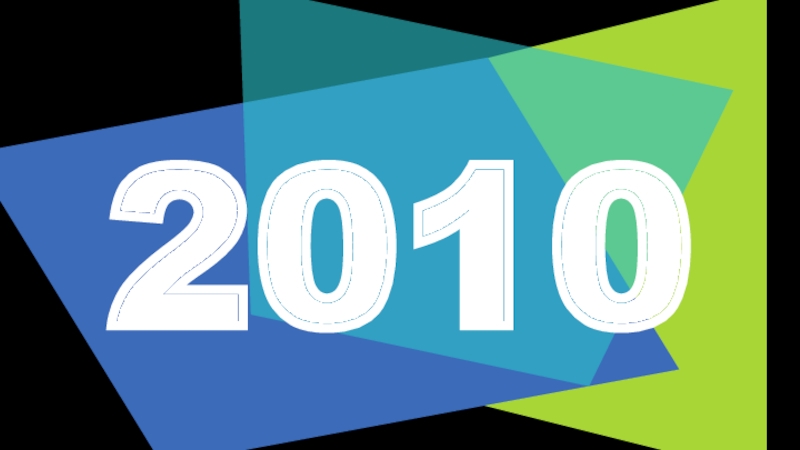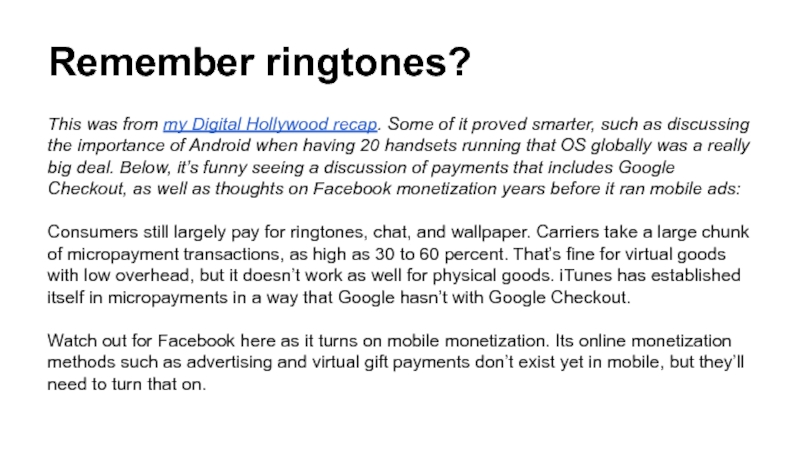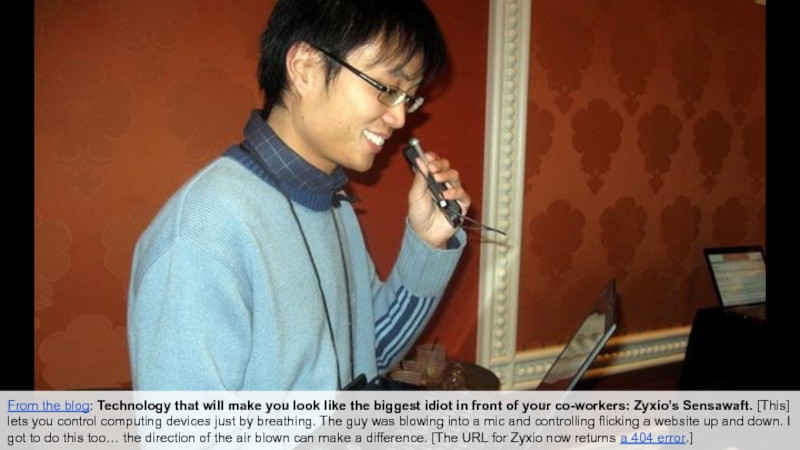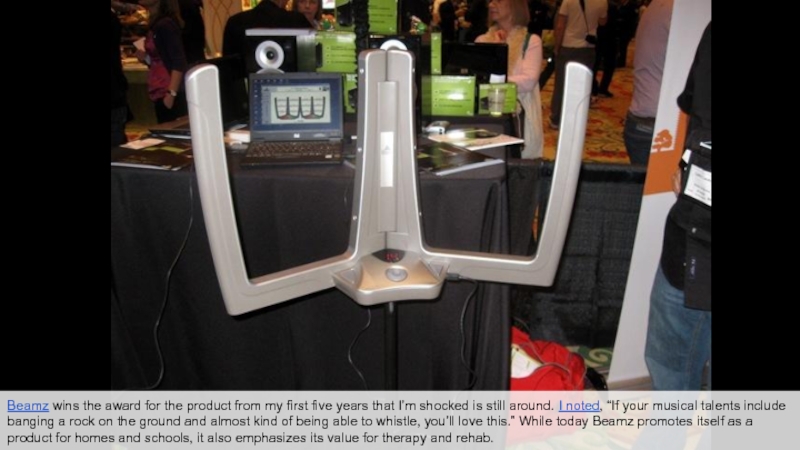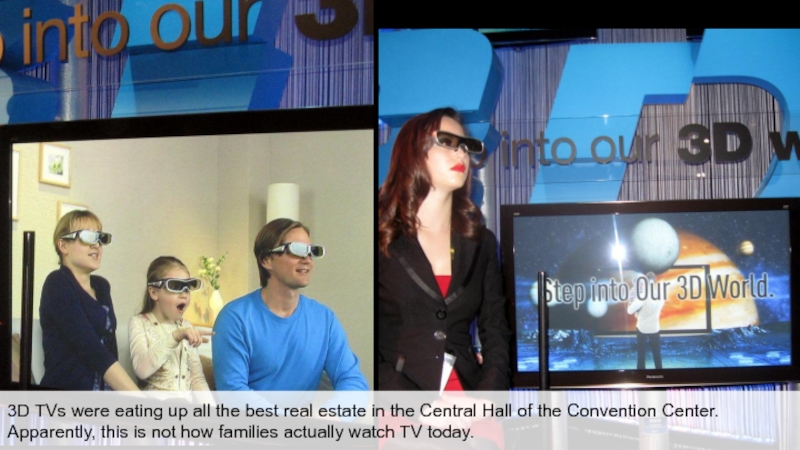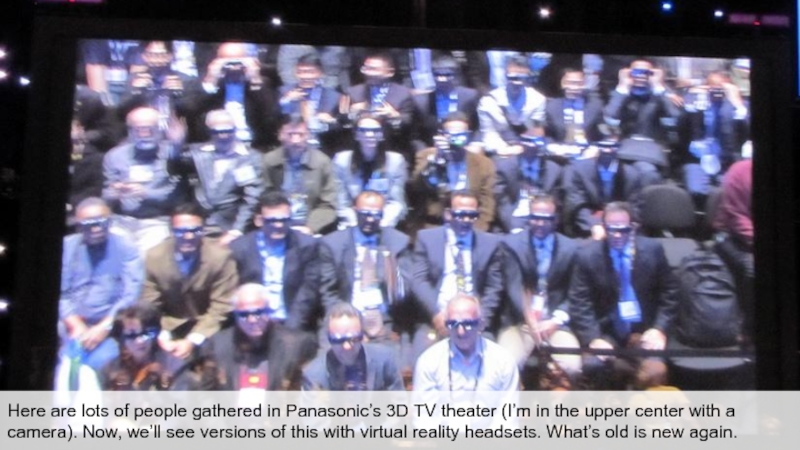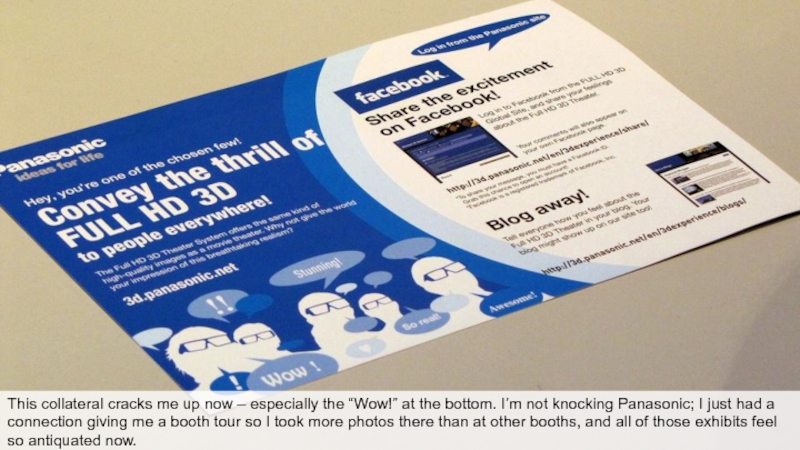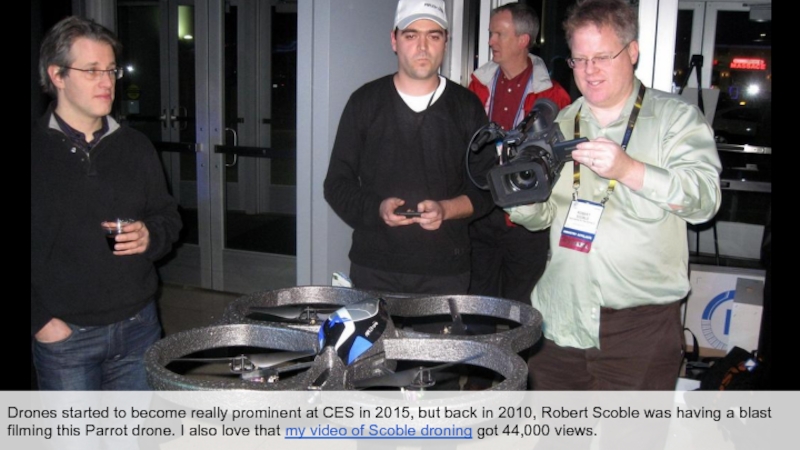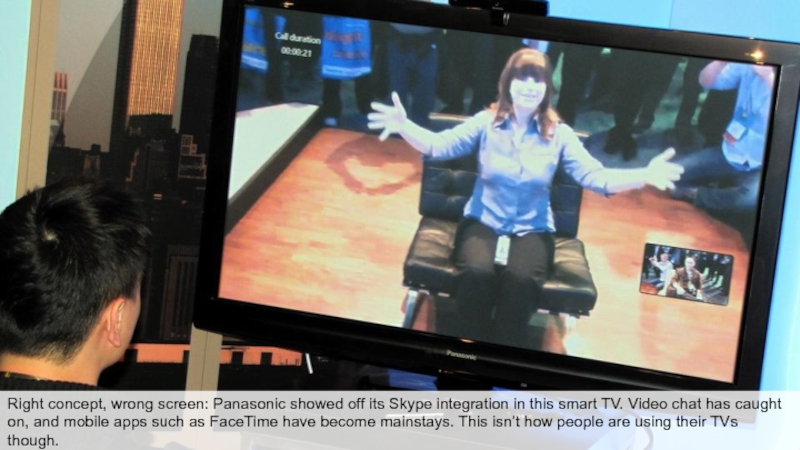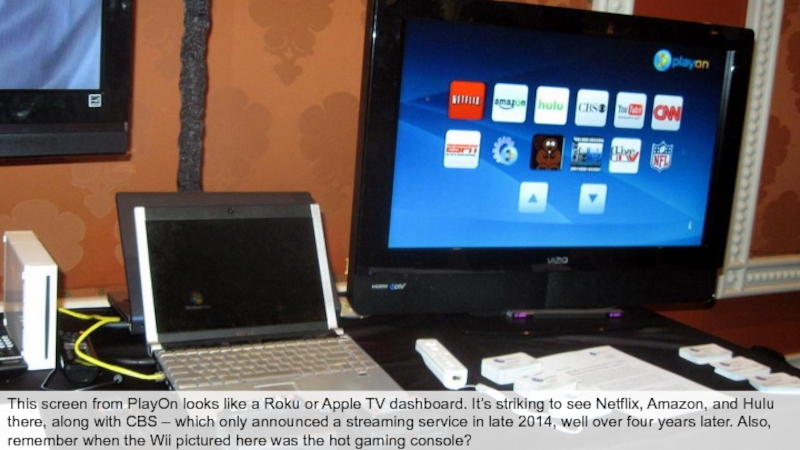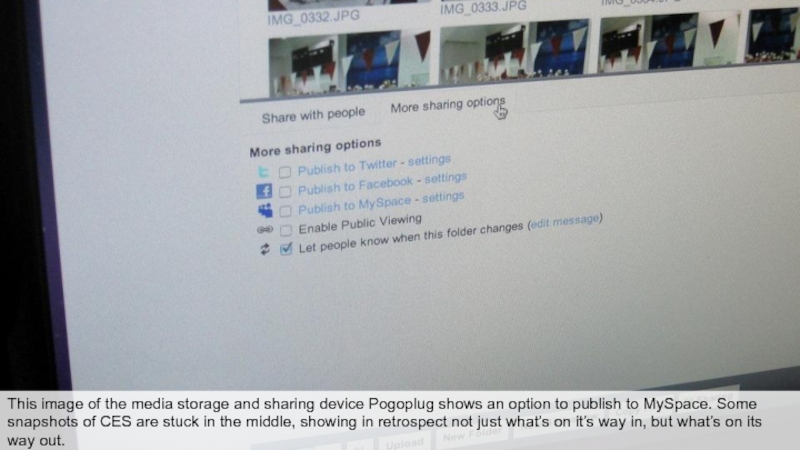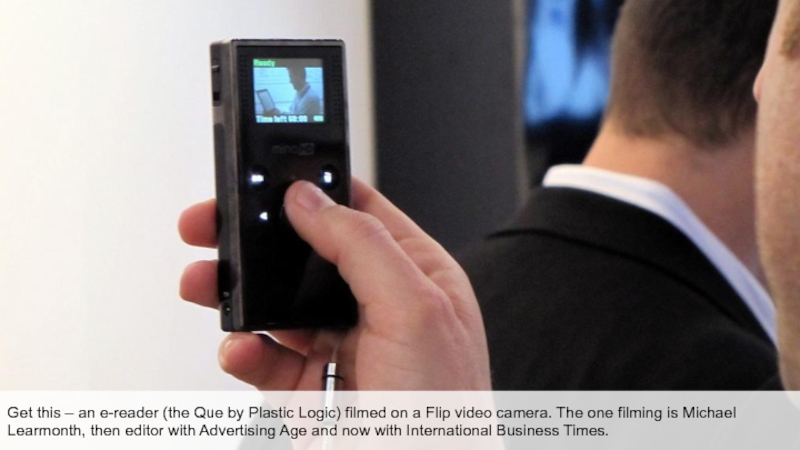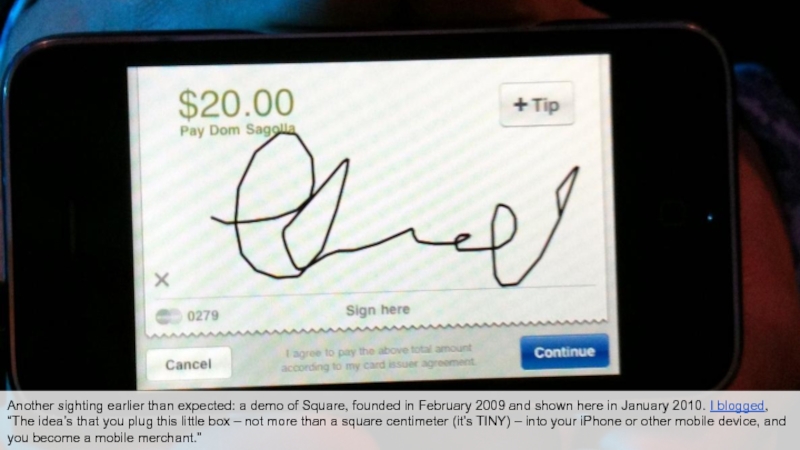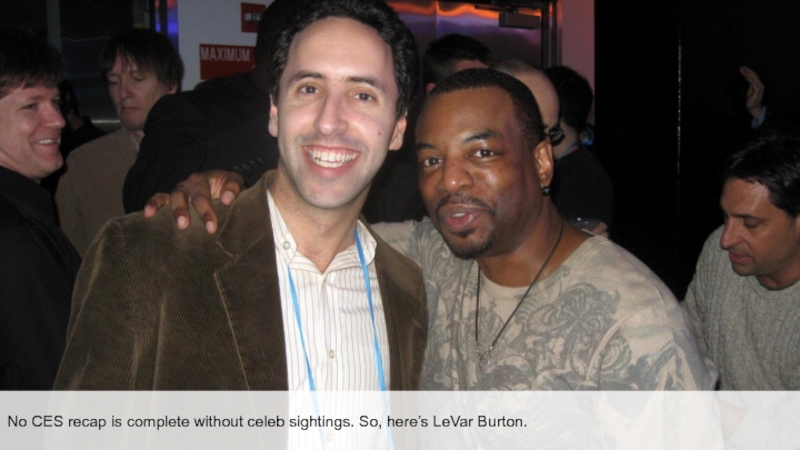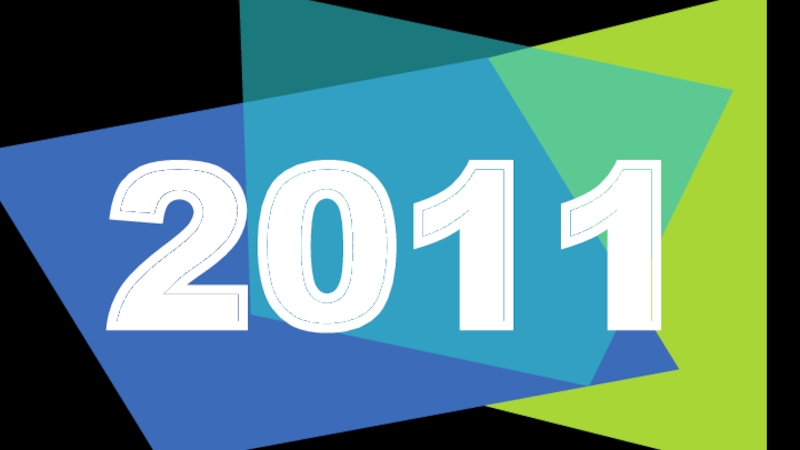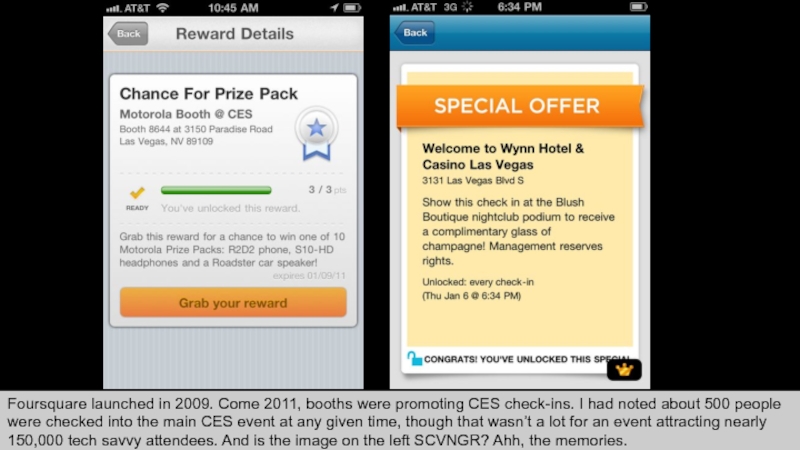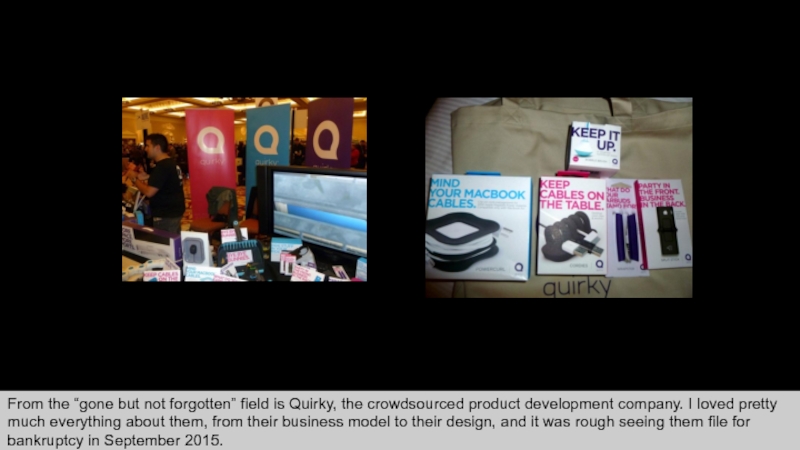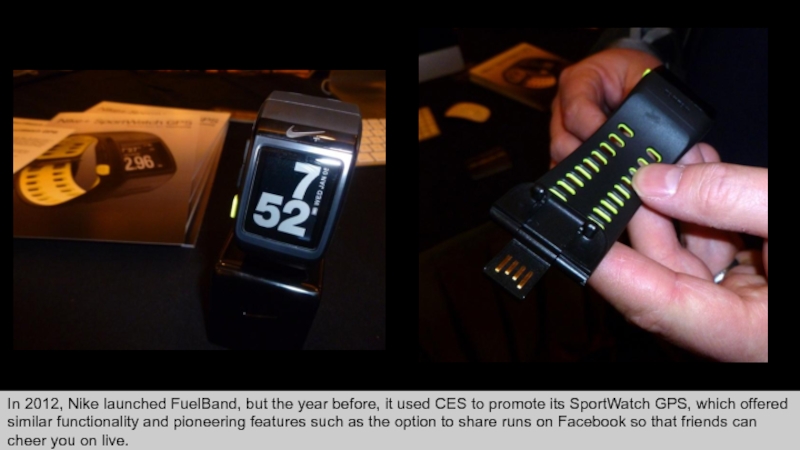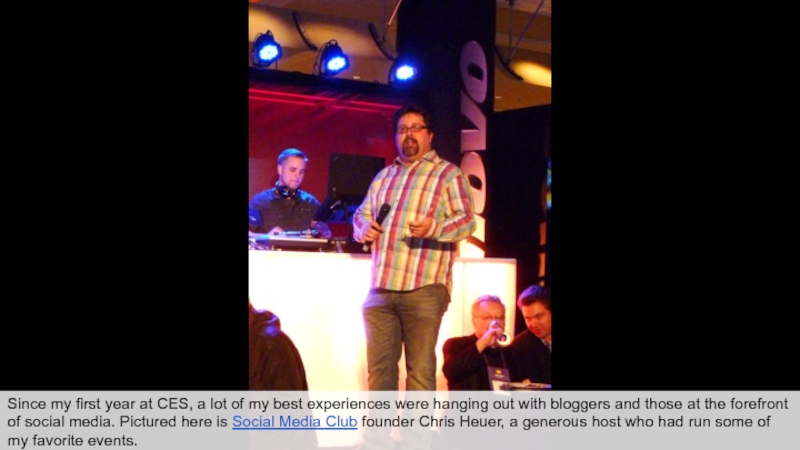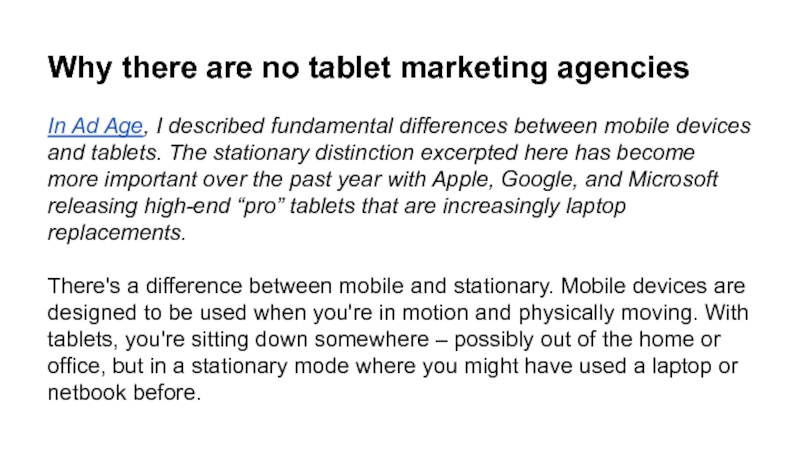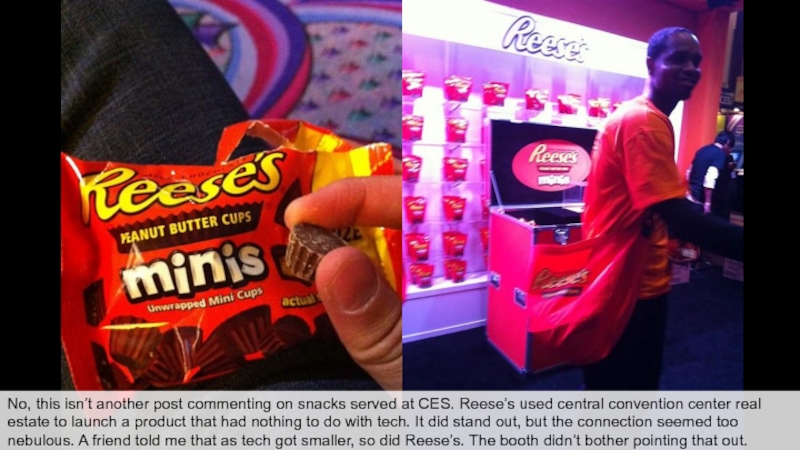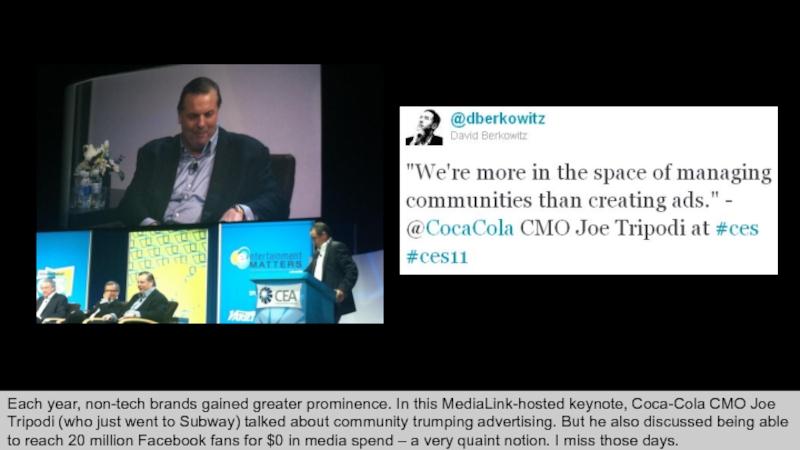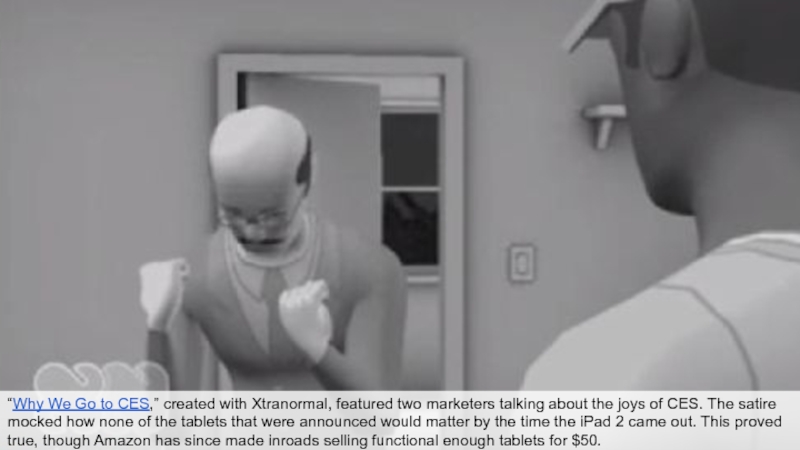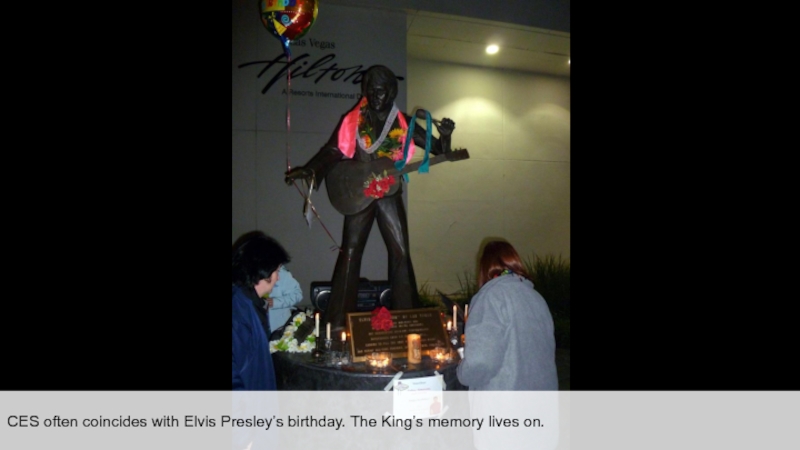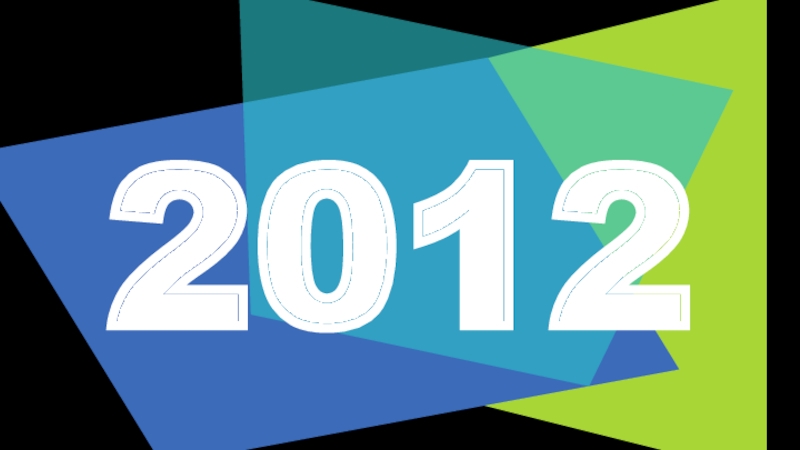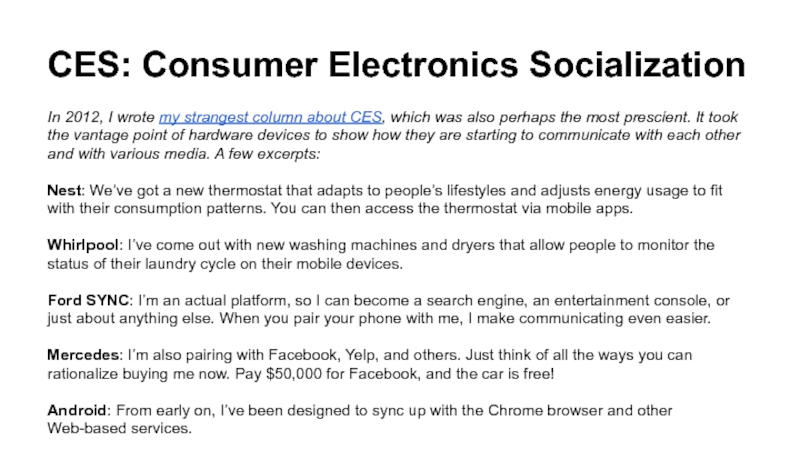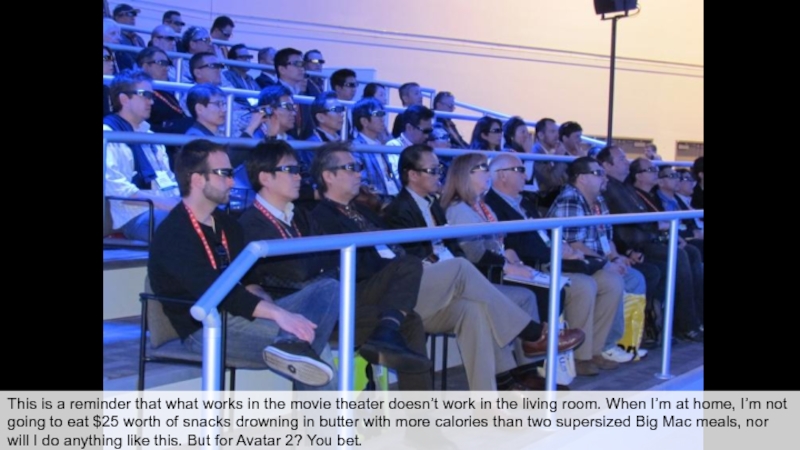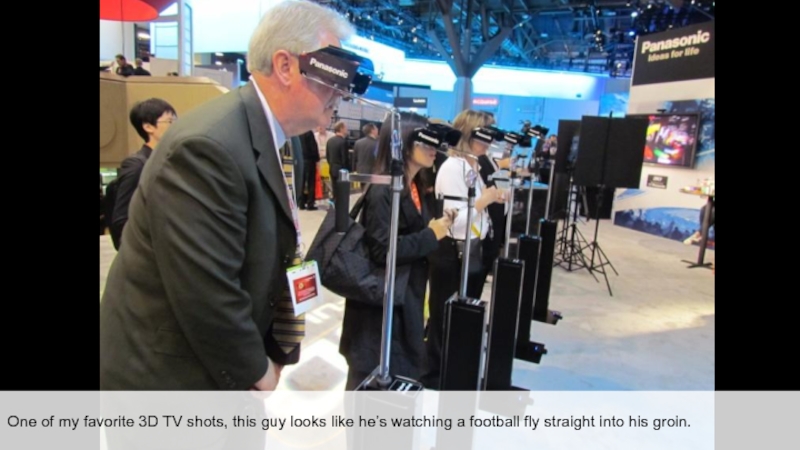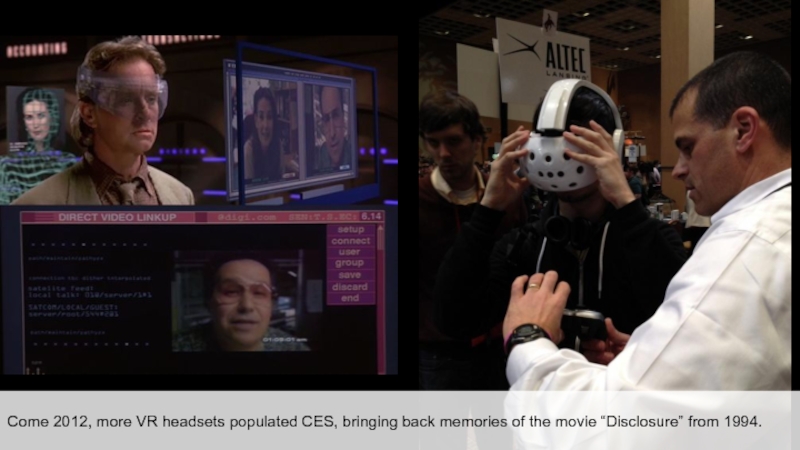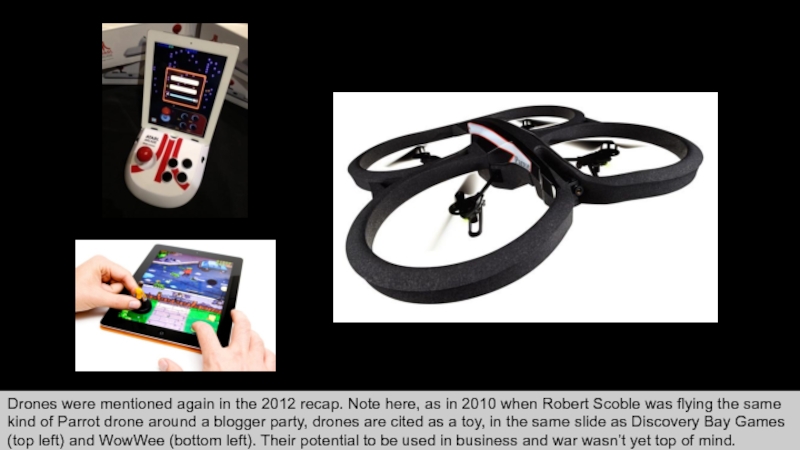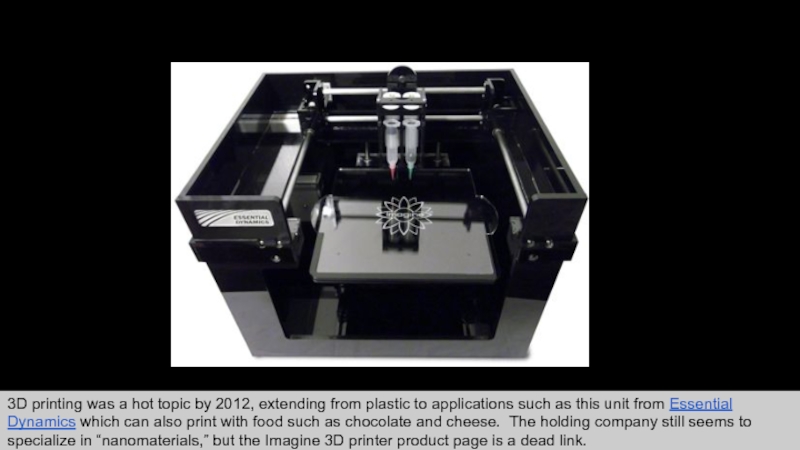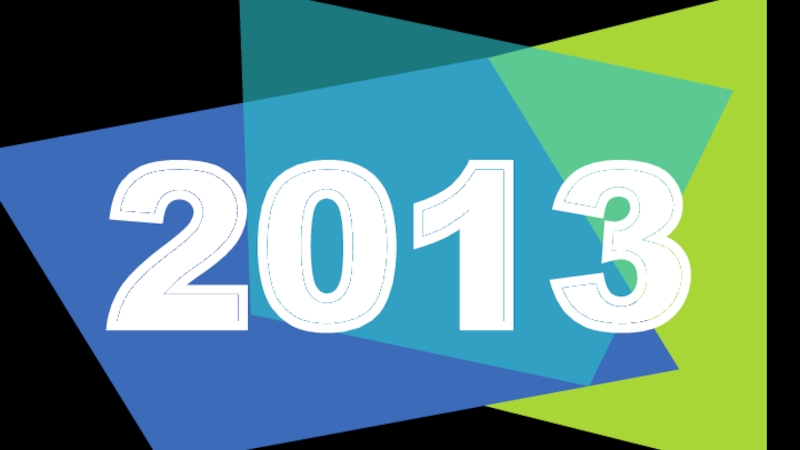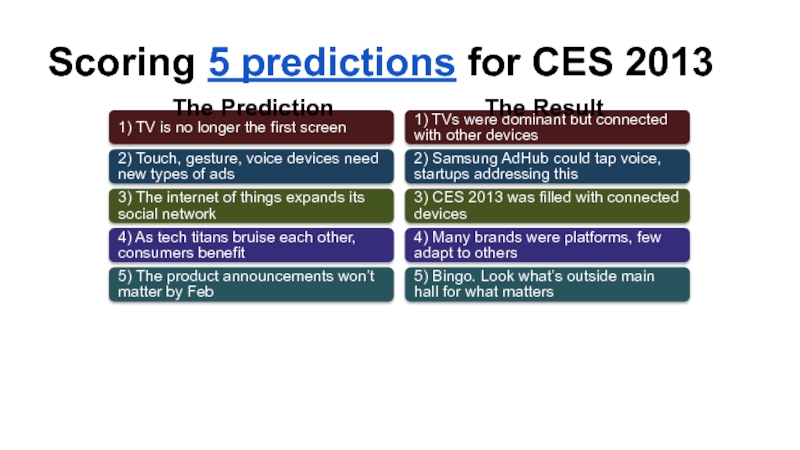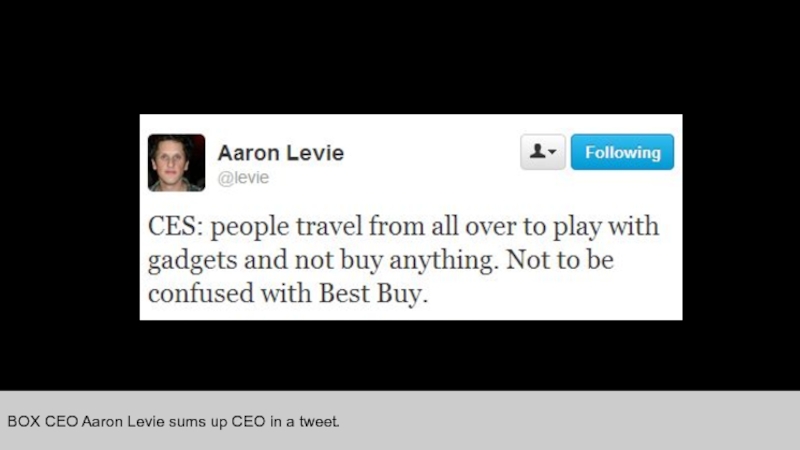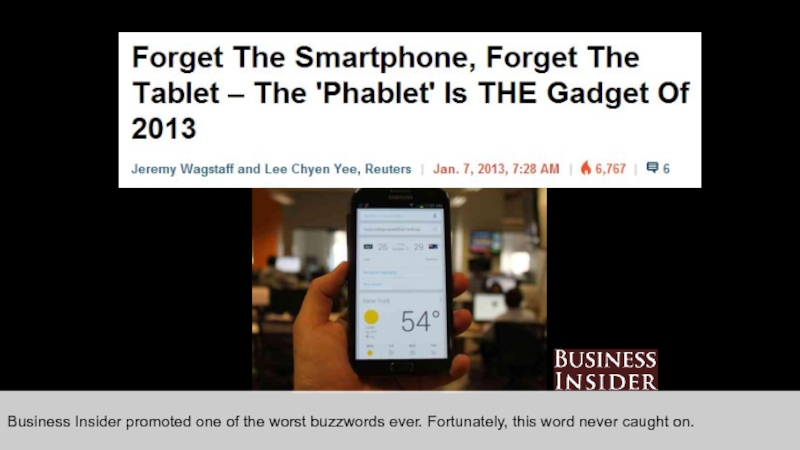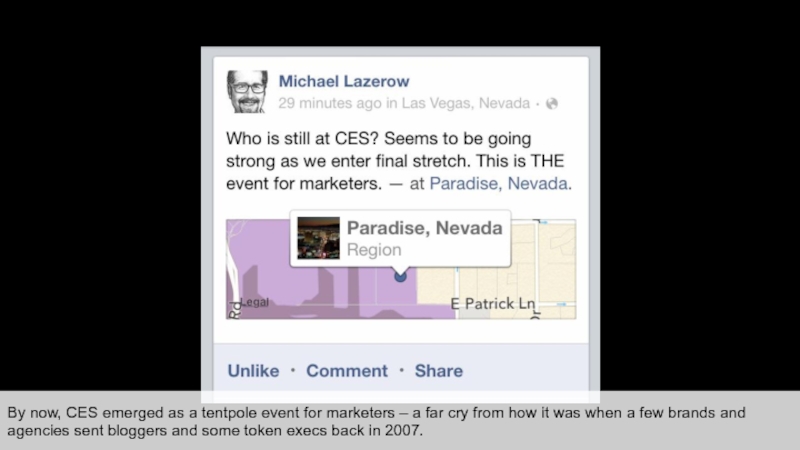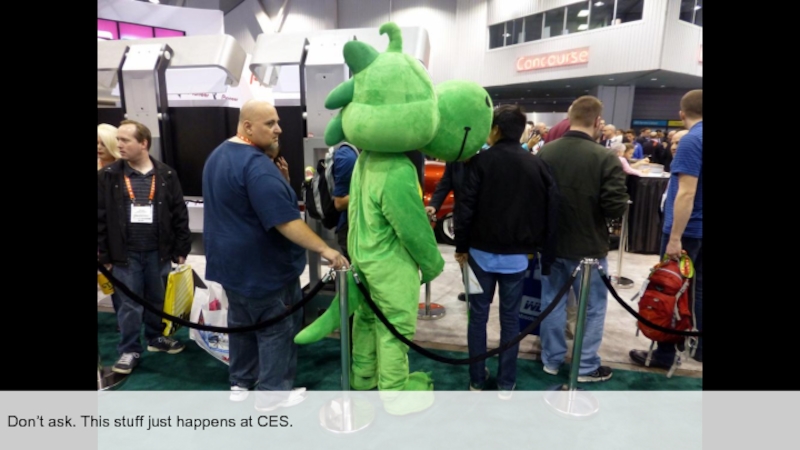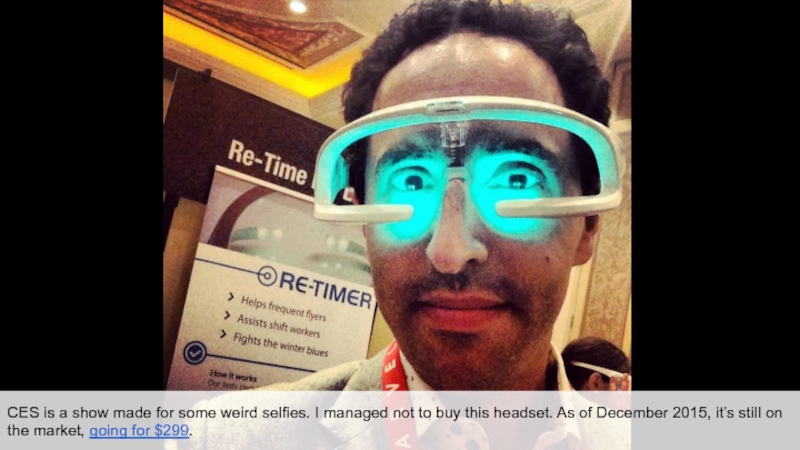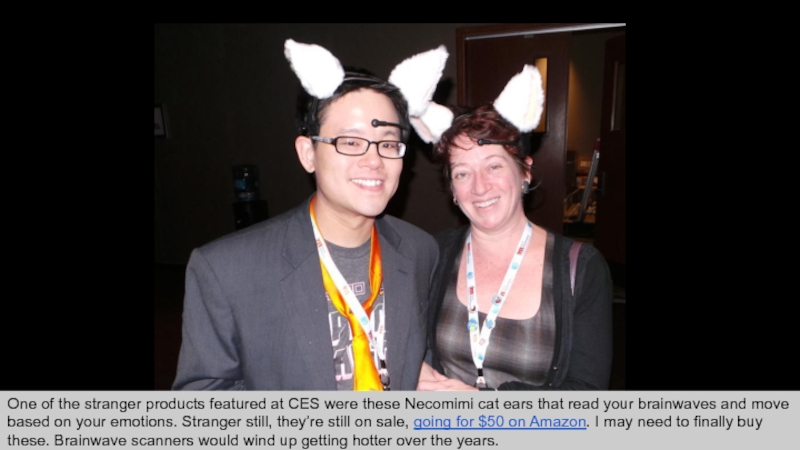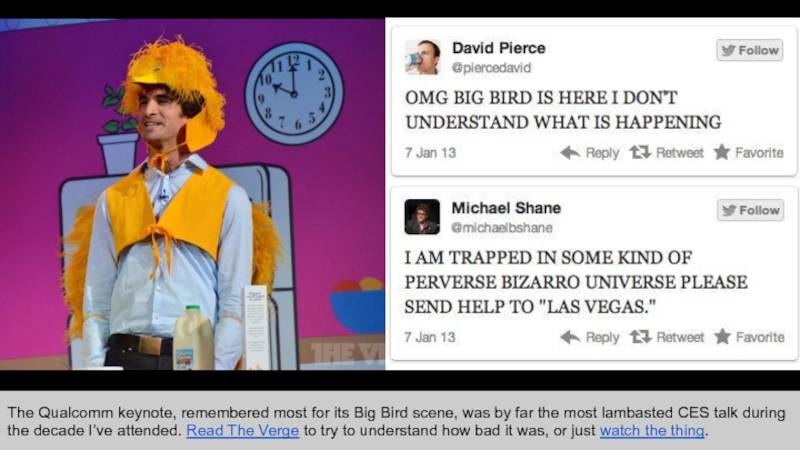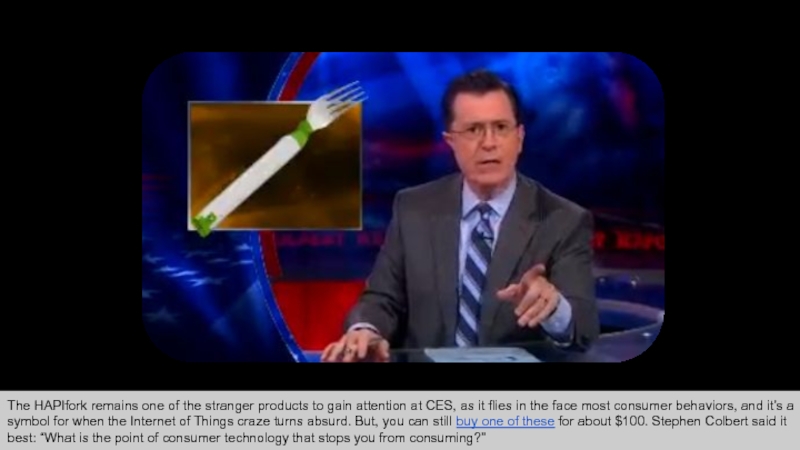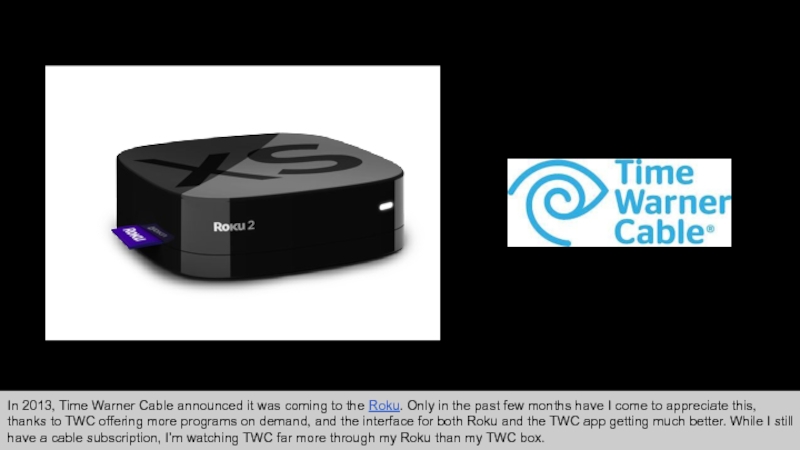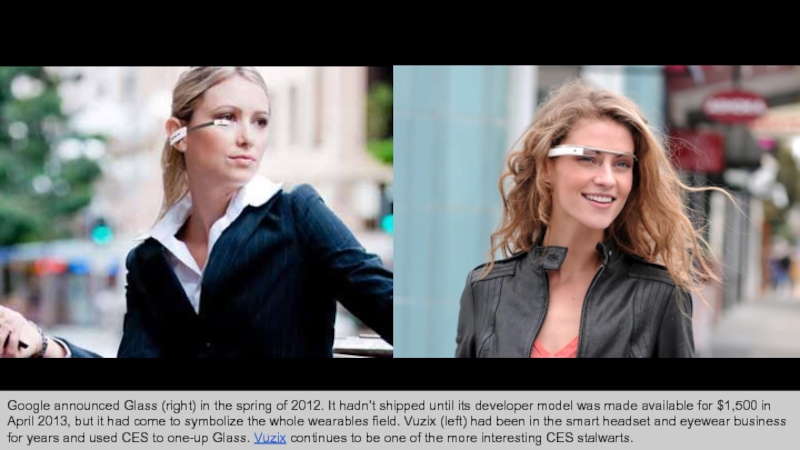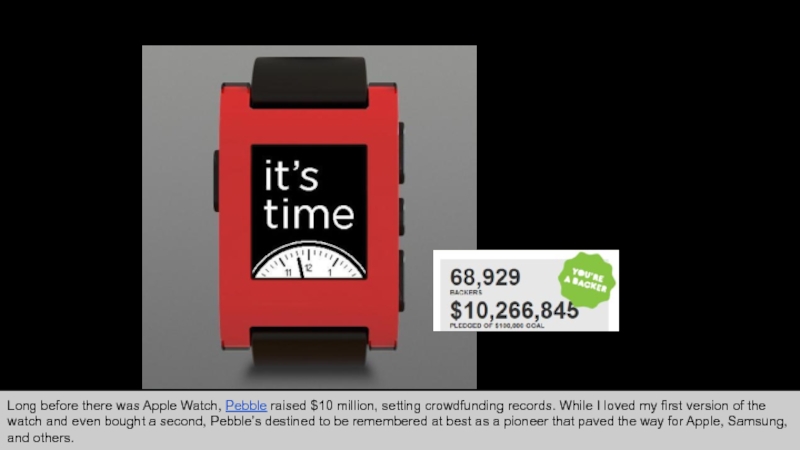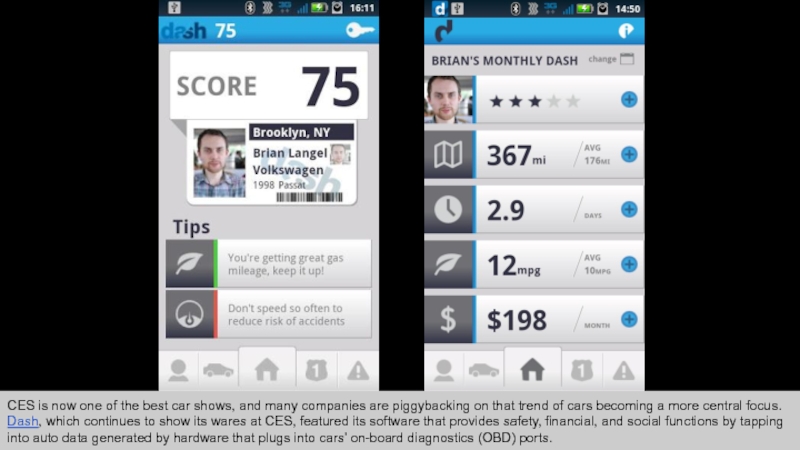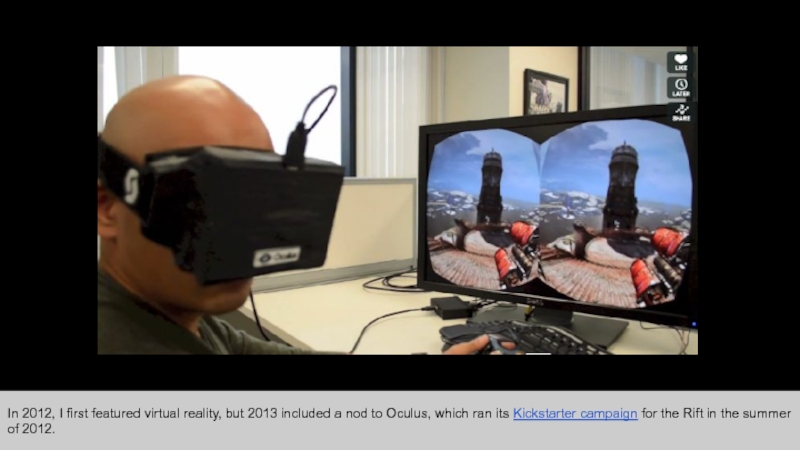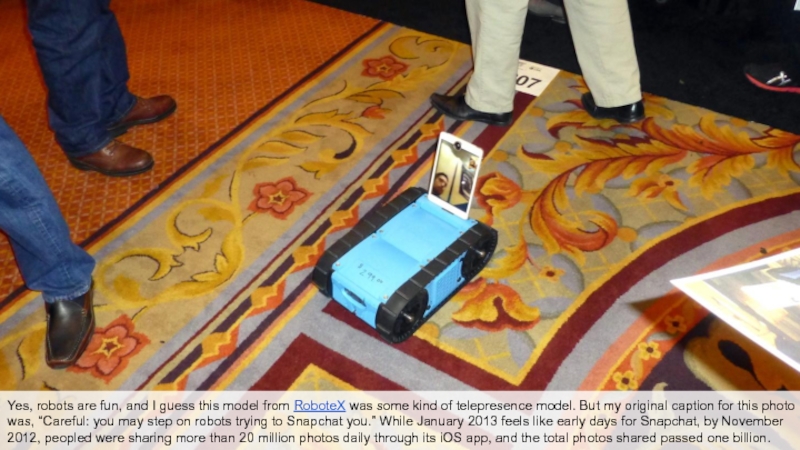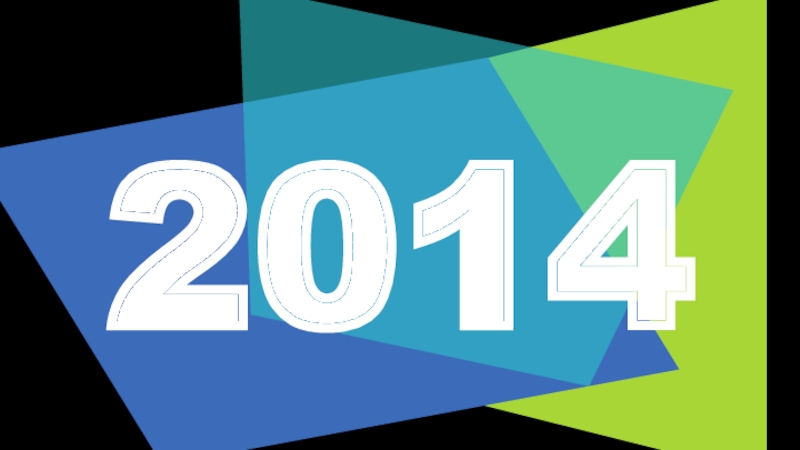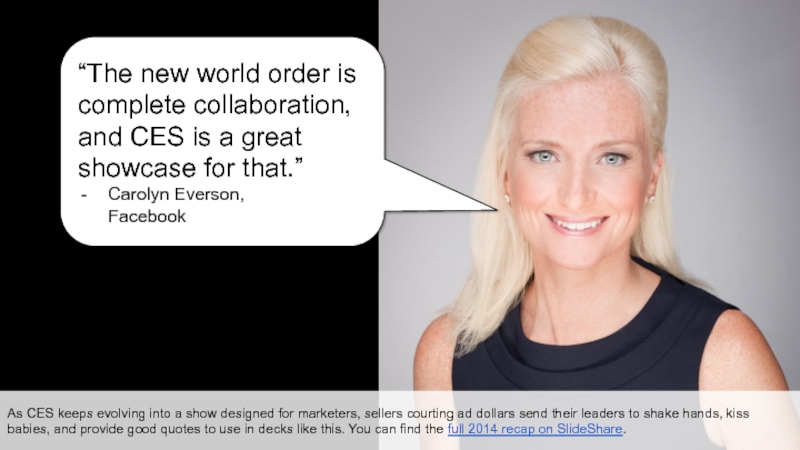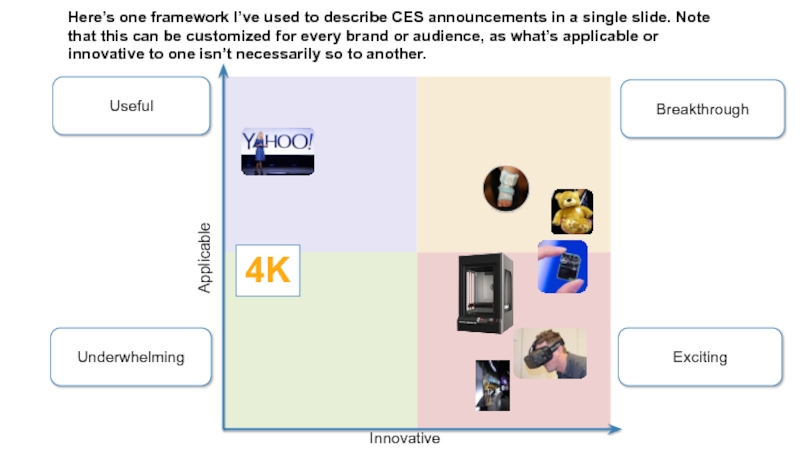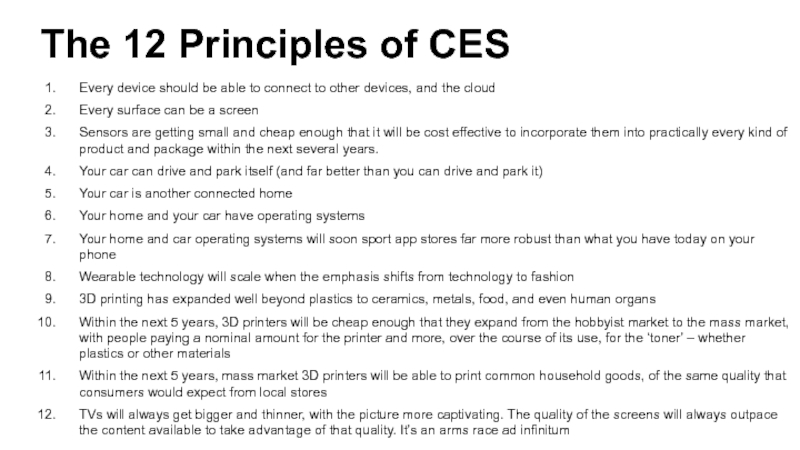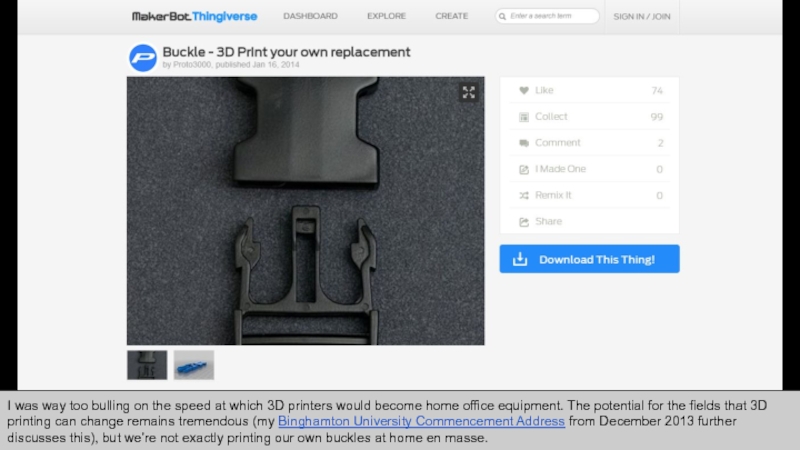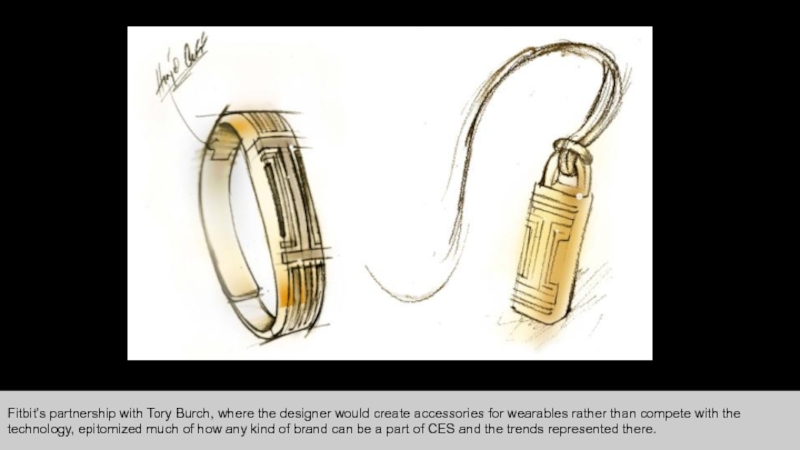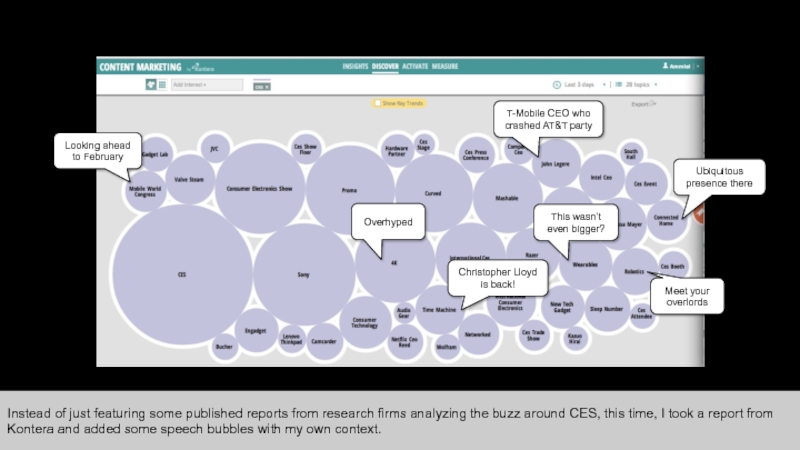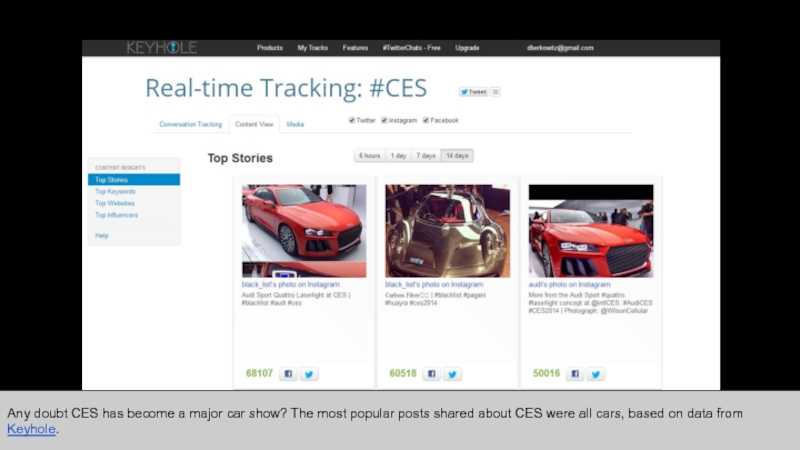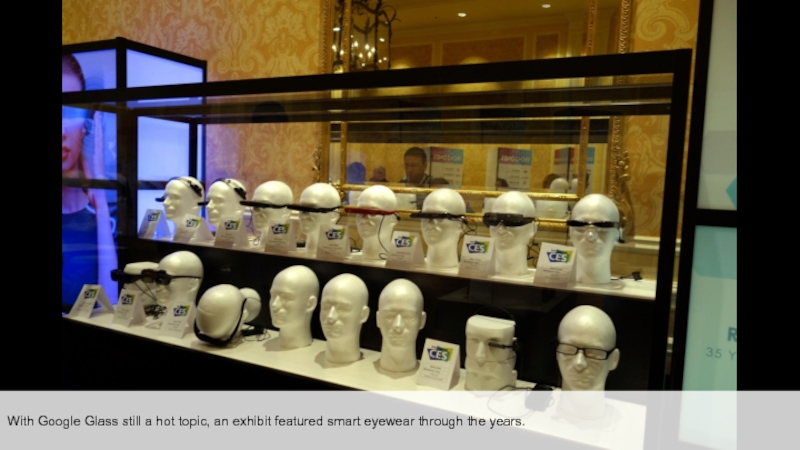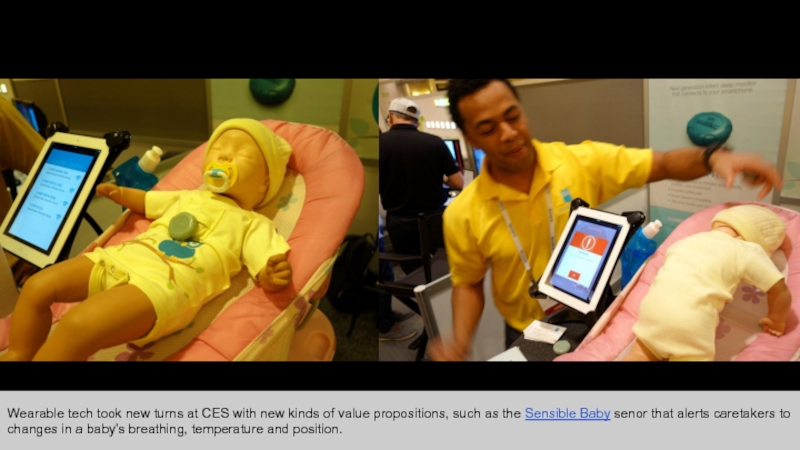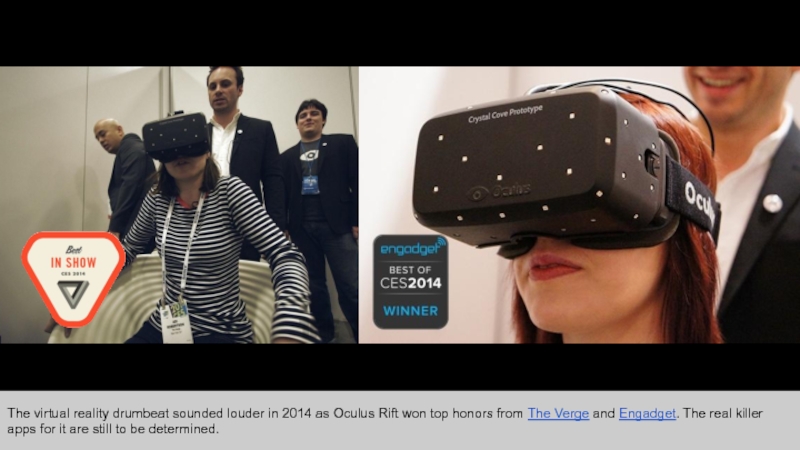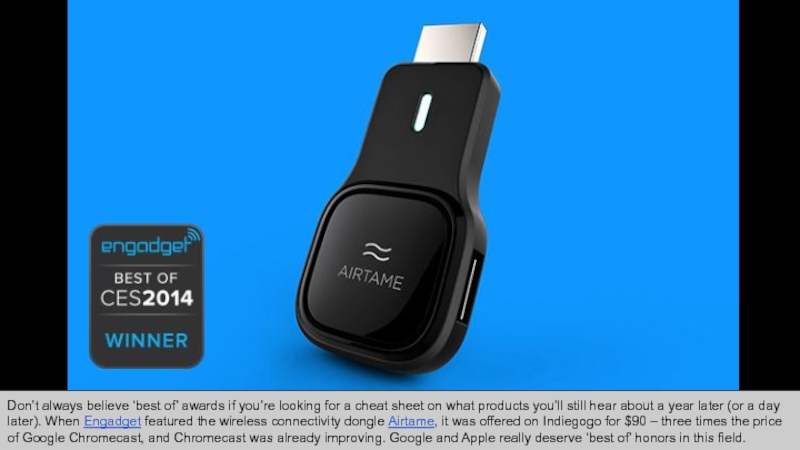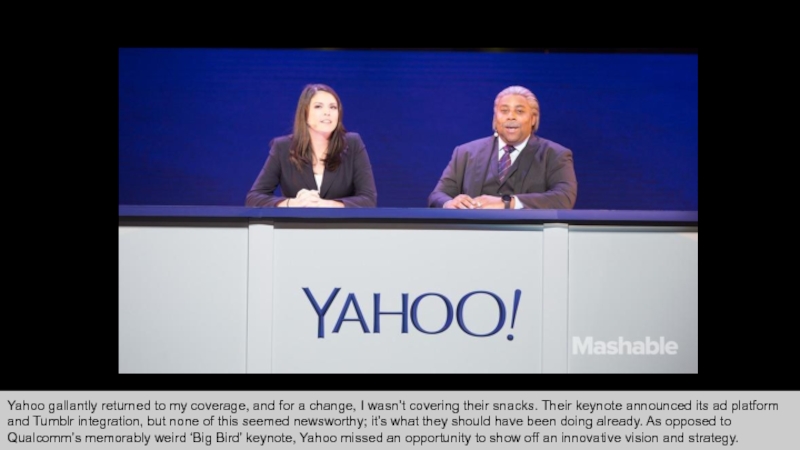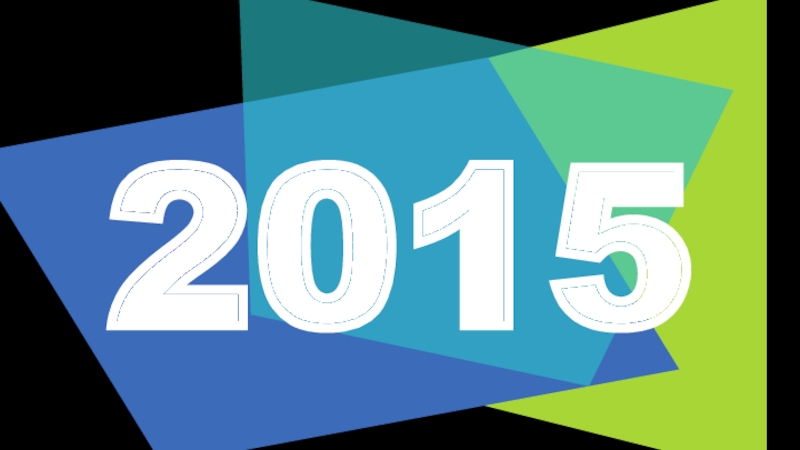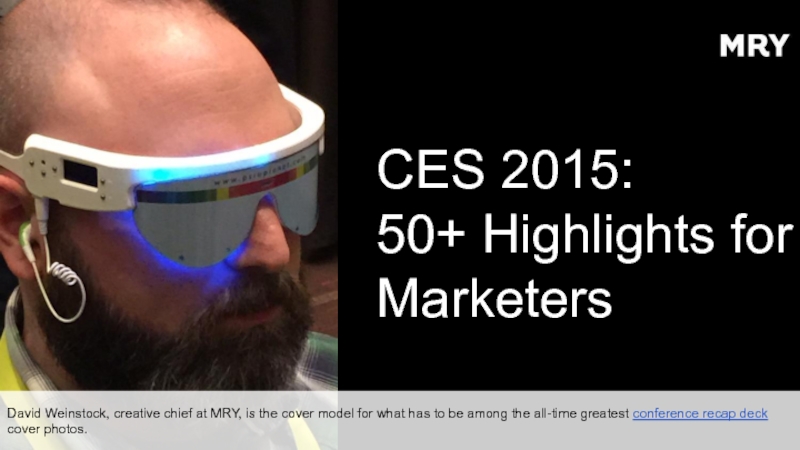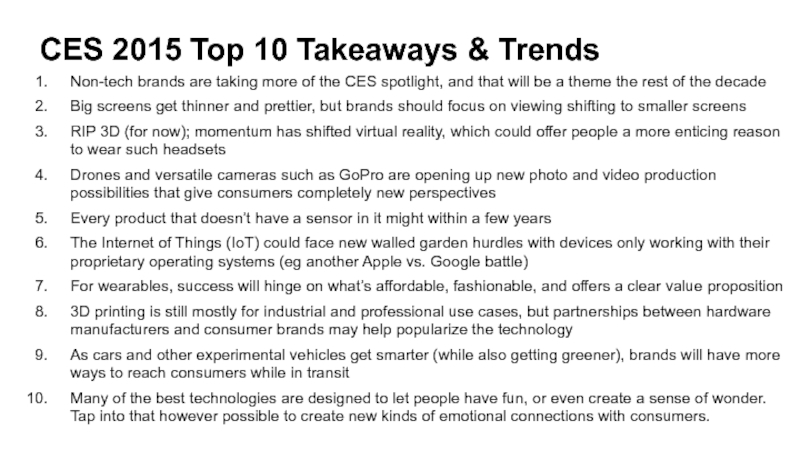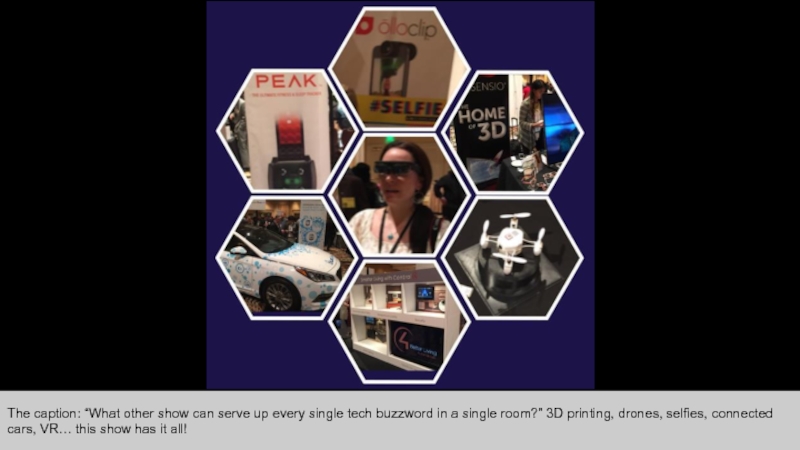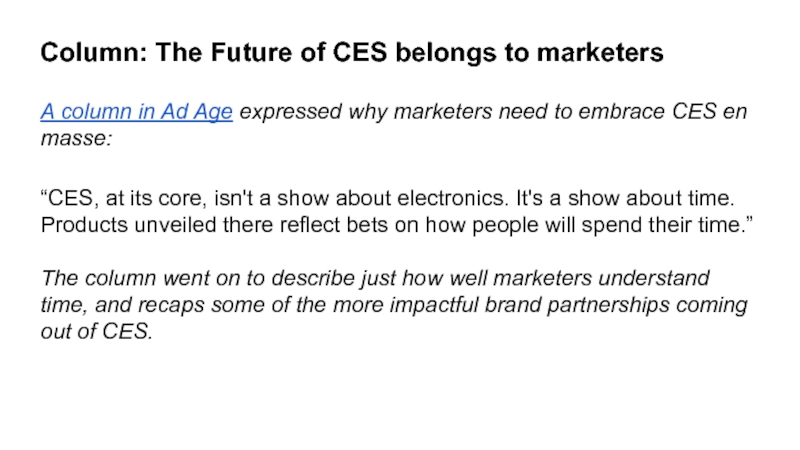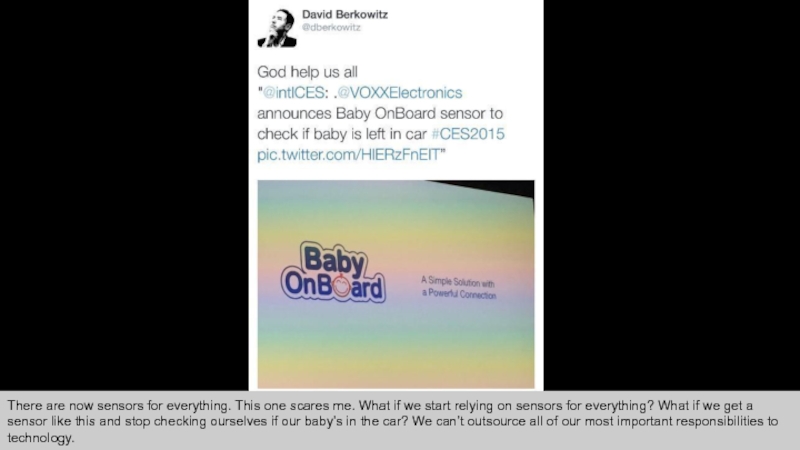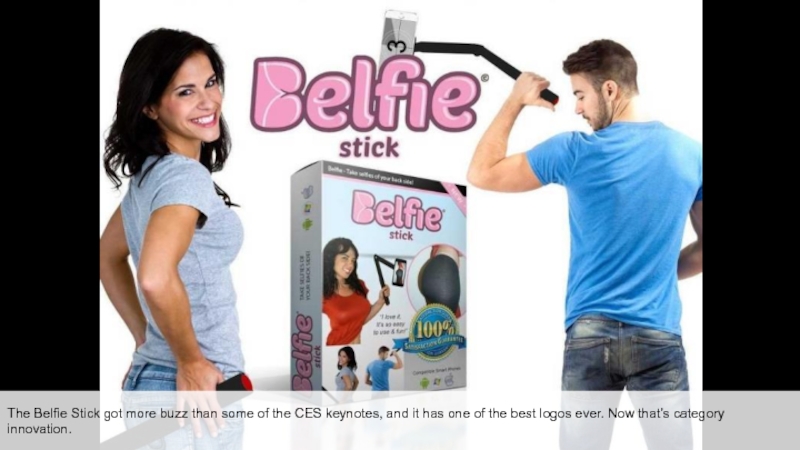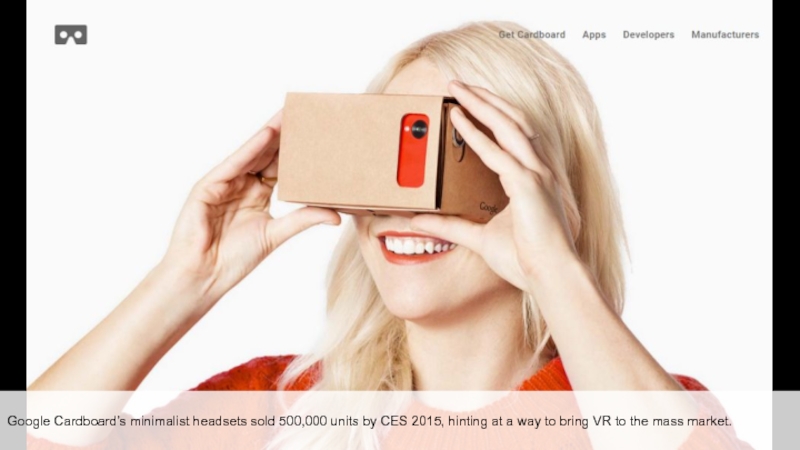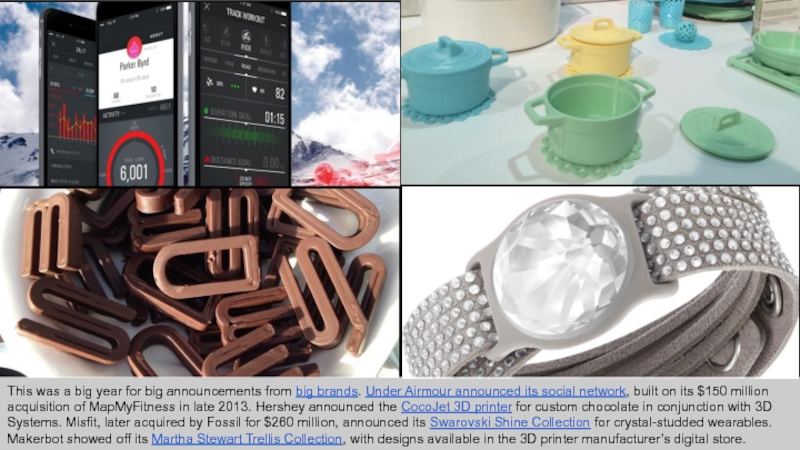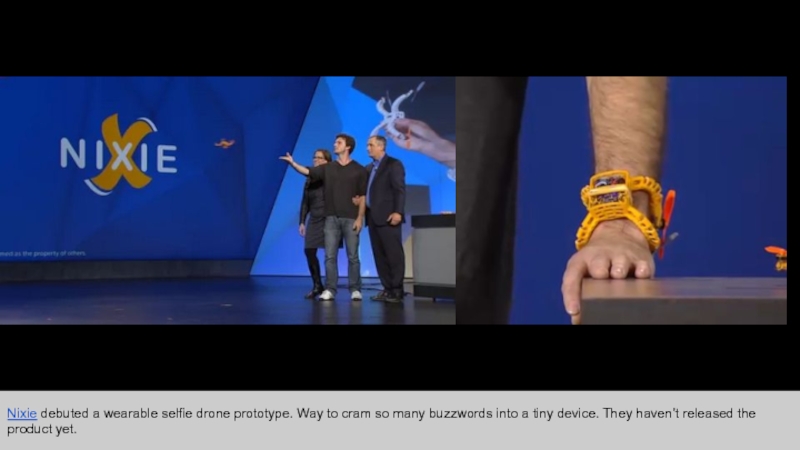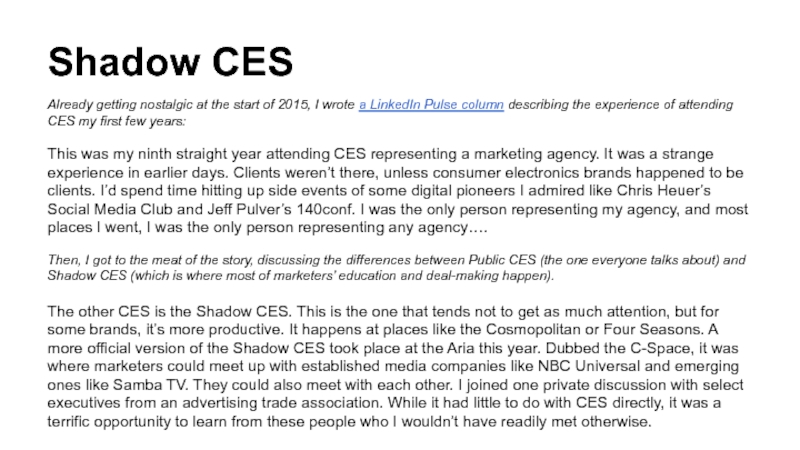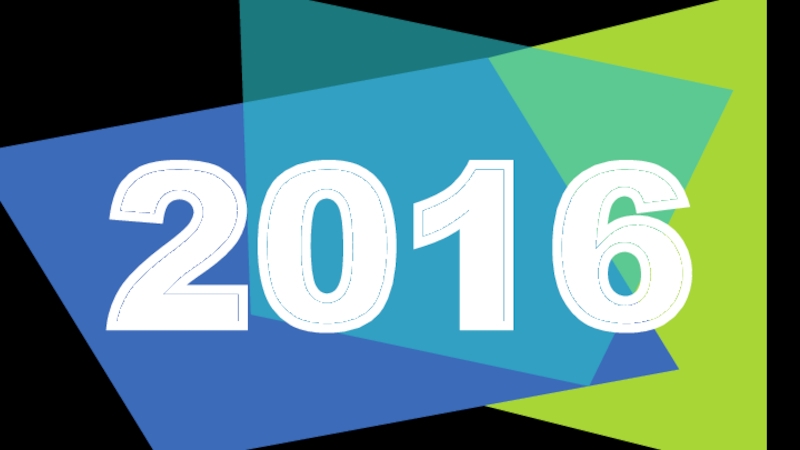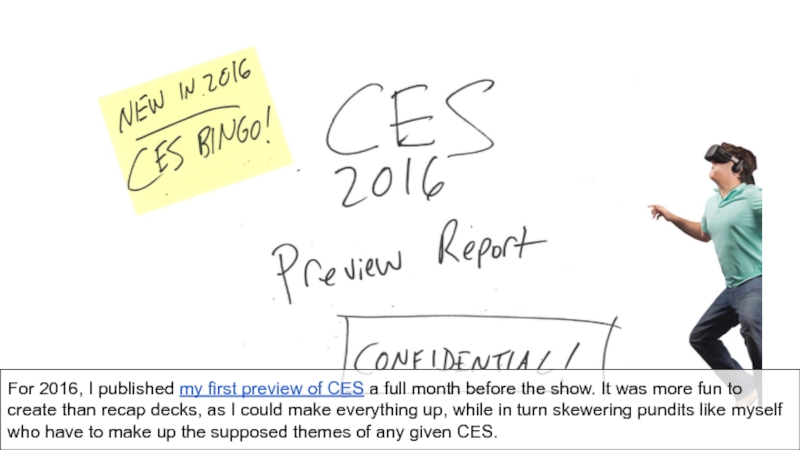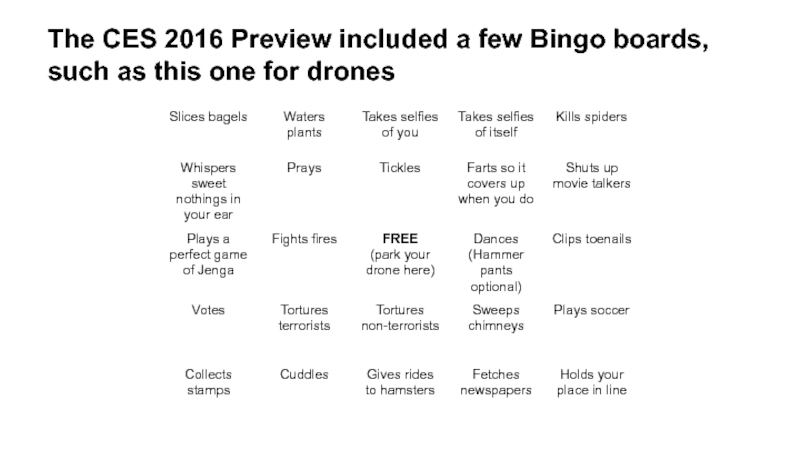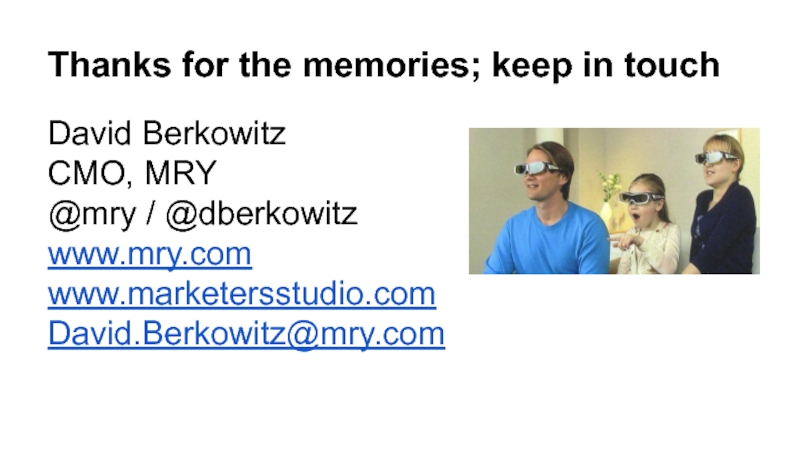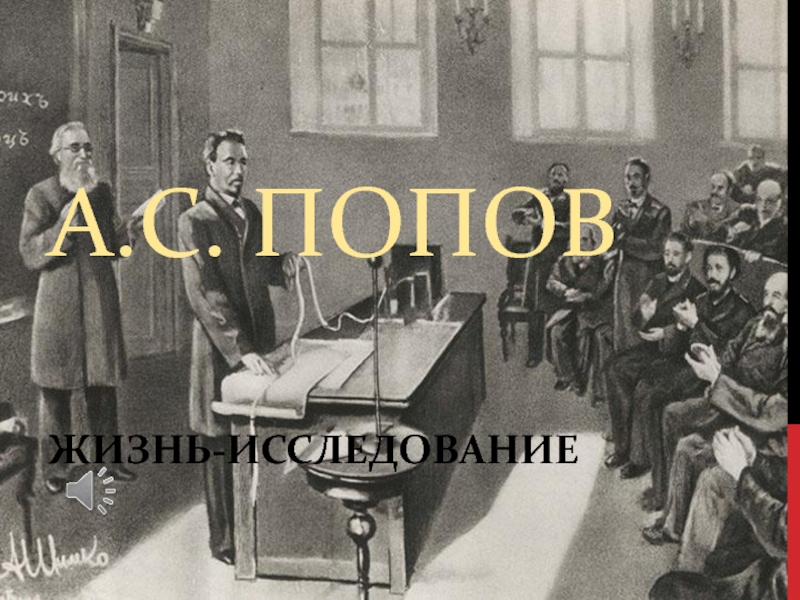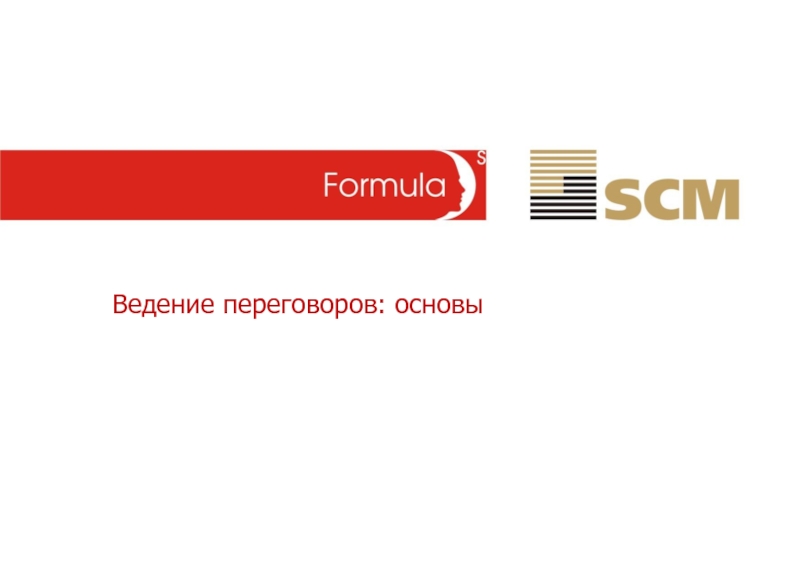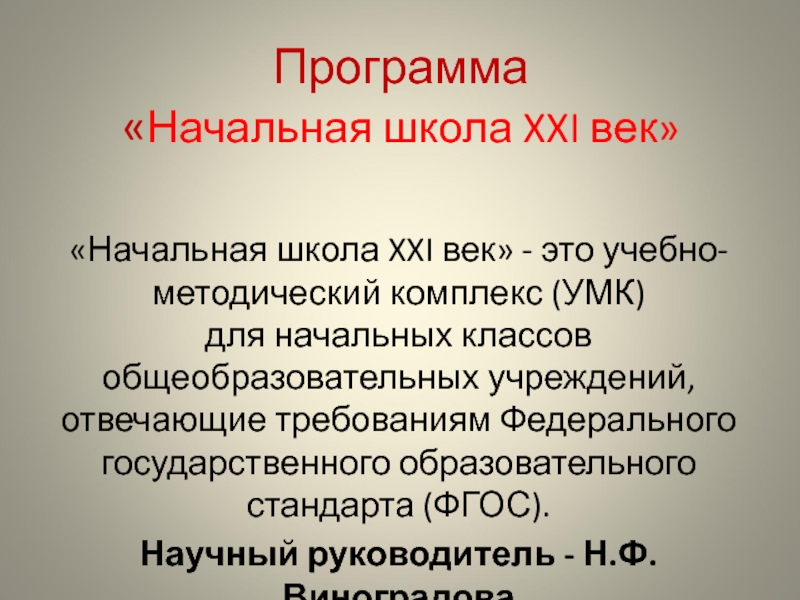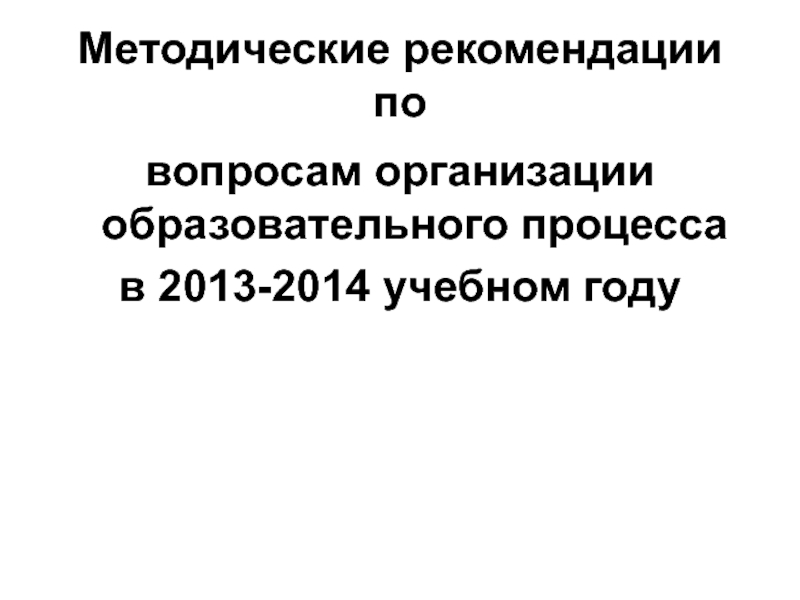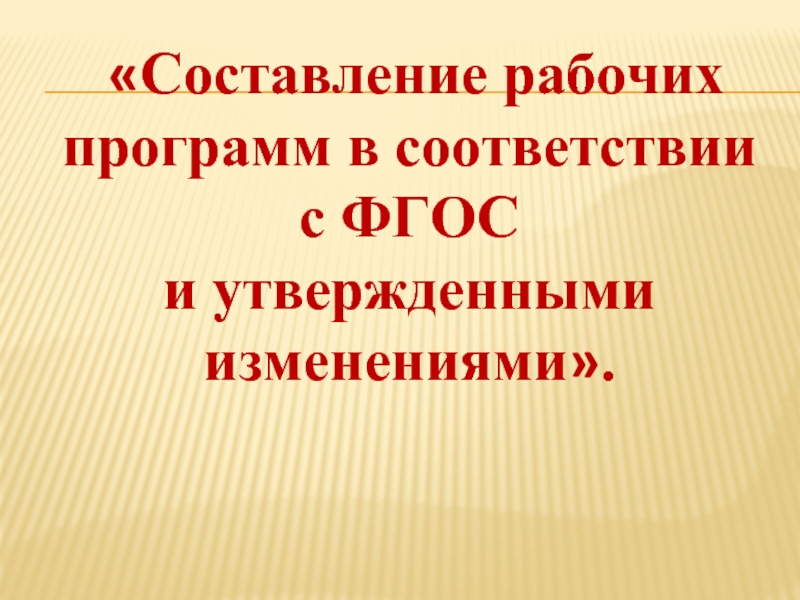- Главная
- Разное
- Дизайн
- Бизнес и предпринимательство
- Аналитика
- Образование
- Развлечения
- Красота и здоровье
- Финансы
- Государство
- Путешествия
- Спорт
- Недвижимость
- Армия
- Графика
- Культурология
- Еда и кулинария
- Лингвистика
- Английский язык
- Астрономия
- Алгебра
- Биология
- География
- Детские презентации
- Информатика
- История
- Литература
- Маркетинг
- Математика
- Медицина
- Менеджмент
- Музыка
- МХК
- Немецкий язык
- ОБЖ
- Обществознание
- Окружающий мир
- Педагогика
- Русский язык
- Технология
- Физика
- Философия
- Химия
- Шаблоны, картинки для презентаций
- Экология
- Экономика
- Юриспруденция
CES 2007-201610 Years in Reviewby David BerkowitzCMO, MRYDavid.Berkowitz@mry.com@dberkowitz презентация
Содержание
- 1. CES 2007-201610 Years in Reviewby David BerkowitzCMO, MRYDavid.Berkowitz@mry.com@dberkowitz
- 2. Table of Contents Overview 2007 2008
- 3. Time Travel: 10 Years of CES Attending
- 4. 2007
- 5. My first words written about CES
- 6. A sign of the economic troubles to
- 7. Go figure… my first photo from
- 8. One of my favorite photos from
- 9. “[I’m] blogging away with the Dell
- 10. It’s a pleasant surprise reviewing photos
- 11. 2008
- 12. Some things don’t change fast enough In
- 13. Among the best marketing I’ve encountered
- 14. I really was obsessed with Yahoo’s snacks
- 15. 2009
- 16. “In January 2009, I did a
- 17. I met Ford President and
- 18. Ford launches Sync with Microsoft Doug VanDagens,
- 19. Going for the hat trick, I interviewed
- 20. Robert Scoble on Reading Friends For a
- 21. 2010
- 22. Remember ringtones? This was from my
- 23. From the blog: Technology
- 24. Beamz wins the award for the
- 25. 3D TVs were eating up all
- 26. Here are lots of people gathered
- 27. This collateral cracks me up
- 28. Drones started to become
- 29. Right concept, wrong screen: Panasonic
- 30. This screen from PlayOn looks
- 31. This image of the media
- 32. Get this – an e-reader
- 33. Another sighting earlier than expected:
- 34. No CES recap is complete without celeb sightings. So, here’s LeVar Burton.
- 35. 2011
- 36. Foursquare launched in 2009. Come 2011,
- 37. From the “gone but not forgotten”
- 38. In 2012, Nike launched FuelBand, but
- 39. Since my first year at CES,
- 40. Why there are no tablet marketing agencies
- 41. No, this isn’t another post commenting
- 42. Big brands, bigger ideas Each year,
- 43. Complete 2011 roundup http://www.marketersstudio.com/2011/01/the-full-consumer-electronics-show-ces-multimedia-multiplatform-coverage-roundup-spectactular.html “Why We
- 44. CES often coincides with Elvis Presley’s birthday. The King’s memory lives on.
- 45. 2012
- 46. CES: Consumer Electronics Socialization In 2012, I
- 47. 3D TV This is a reminder
- 48. 3D TV One of my favorite
- 49. Virtual reality headgear by Sensics (proof
- 50. Drones were mentioned again in the
- 51. 3D printing was a hot topic
- 52. 2013
- 53. Scoring 5 predictions for CES 2013 1)
- 54. BOX CEO Aaron Levie sums up CEO in a tweet.
- 55. Business Insider promoted one of the
- 56. By now, CES emerged as a
- 57. Don’t ask. This stuff just happens at CES.
- 58. CES is a show made for
- 59. One of the stranger products featured
- 60. The Qualcomm keynote, remembered most for
- 61. Colbert on HAPIfork “ The HAPIfork
- 62. Time Warner Cable comes to Roku
- 63. Google announced Glass (right) in the
- 64. Long before there was Apple Watch,
- 65. ODB enables an API CES is
- 66. Reality can still be virtual and
- 67. Yes, robots are fun, and I
- 68. 2014
- 69. “The new world order is complete
- 70. Here’s one framework I’ve used to describe
- 71. The 12 Principles of CES Every device
- 72. I was way too bulling
- 73. Fitbit’s partnership with Tory Burch, where
- 74. Overhyped T-Mobile CEO who crashed AT&T
- 75. Any doubt CES has become a
- 76. With Google Glass still a hot
- 77. Wearable tech took new turns at
- 78. The virtual reality drumbeat sounded louder
- 79. Don’t always believe ‘best of’ awards
- 80. Yahoo gallantly returned to my coverage,
- 81. 2015
- 82. CES 2015: 50+ Highlights for
- 83. CES 2015 Top 10 Takeaways & Trends
- 84. The caption: “What other show can
- 85. Column: The Future of CES belongs to
- 86. There are now sensors for everything.
- 87. The Belfie Stick got more
- 88. Google Cardboard’s minimalist headsets sold 500,000
- 89. This was a big year for
- 90. Nixie debuted a wearable selfie drone
- 91. Shadow CES Already getting nostalgic at the
- 92. 2016
- 93. For 2016, I published my first
- 94. The CES 2016 Preview included a few Bingo boards, such as this one for drones
- 95. Highlights and final thoughts
- 96. Thanks for the memories; keep in touch
Слайд 1
CES 2007-2016
10 Years in Review
by David Berkowitz
CMO, MRY
David.Berkowitz@mry.com
@dberkowitz
Слайд 3Time Travel: 10 Years of CES
Attending CES for ten years means
But, 10 CES’s is something, and attending my tenth one in 2016 has made me nostalgic for the early days, back when I wrote more blog posts than columns and presentations, and back when the snacks a tech company served mattered as much to me as the impact of that tech on my clients’ businesses.
As I prepared for CES 2016, I looked back through all my files – blog posts, Flickr photos, recap decks, columns – and gathered highlights from what I’ve shared publicly (as opposed to anything presented solely to clients). I was repeatedly surprised by early mentions of topics such as drones, virtual reality, and the Internet of Things. And yet, I had to wade through countless images of 3D TVs (which I sensed were a flop from the start) and 3D printers (which I was way too bullish on in terms of applications for mass market usage in the home).
I noted rather loftily in Advertising Age in 2015, “CES, at its core, isn't a show about electronics. It's a show about time.” What you’ll find here takes a broader view of time than what we’re normally afforded in a typical column or deck or tweet. It offers the perspective that a single year’s analysis can’t provide. If it interests or moves or inspires you in any way, please let me know.
Thanks for your time.
David Berkowitz David.Berkowitz@mry.com
Слайд 5My first words written about CES (I miss that sense of
“I'm laying low today in advance of CES… It's daunting – all the coverage talking about the #s, somewhere between 1.6 and 2 million square feet of exhibit space, 150,000-170,000 attendees, 984 dancing Elvises…”
Слайд 6A sign of the economic troubles to come?
While representing my
“The woman who helped [with registration] is here with her husband. She's an older woman, presumably here to retire, having lived across the Midwest, Mid-Atlantic, and the South. She said between her husband and herself, they have three Masters degrees between them, and they're making $8.25 an hour.”
Слайд 8 One of my favorite photos from any CES, Yahoo serving the
Слайд 9
“[I’m] blogging away with the Dell blogger, and people from Minnesota,
Слайд 10
It’s a pleasant surprise reviewing photos from that first CES and
Слайд 12Some things don’t change fast enough
In 2008, my roundup included a
“I was taking some notes during my panel at CES. I found that the audience was 85% male, compared to the panel which was 100% male. 20% of the audience wore glasses, compared to 43% of the panelists.”
Image: http://influxis.com/app/uploads/2014/05/photo.jpg
Слайд 13
Among the best marketing I’ve encountered at CES is this children’s
Слайд 14I really was obsessed with Yahoo’s snacks
Could Yahoo have done more
“Biggest letdowns: Yahoo – this year's tent had coffee and assorted nuts, but even the dark chocolate covered peanuts can't compare to last year when they had Cold Stone Creamery (maybe if the stock goes up they'll serve Sprinkles Cupcakes next year)”
The same post further noted the value of the consumer packaged goods innovation known as 100-calorie snack packs.
Слайд 16
“In January 2009, I did a horrible thing in Las Vegas:
Слайд 17
I met Ford President and CEO Alan Mulally, then Ford’s President
Слайд 18Ford launches Sync with Microsoft
Doug VanDagens, Director of Connected Partnerships with
Doug VanDagens: What we're announcing here at the show is an ability to connect to the internet through a normal voice plan. So all you need is your phone, and we can take Sync through Bluetooth, connect to your phone, connect out to Tellme, which is a voice portal - a best in class voice portal, and Microsoft now owns those assets. From there we can direct you to a number of Internet data sources. We can send the GPS information from the vehicle, we can send health report diagnostic information over your voice plan, and then we have traffic, directions, business search, and information, all internet-based.
Слайд 19Going for the hat trick, I interviewed Ford President of the
Слайд 20Robert Scoble on Reading Friends
For a couple years, Jeff Pulver brought
First, he noted Facebook was getting 450,000 new members a day - it grew by 10 million in 3 weeks. Granted, he also plugged FriendFeed, though I commented that he was “not ready to endorse FriendFeed for normal people yet.”
He also described Google Reader. I noted Scoble “doesn’t read his feeds anymore; he reads his friends.” Today, that happens more than ever, though that behavior most prominently takes place on Facebook.
Слайд 22Remember ringtones?
This was from my Digital Hollywood recap. Some of
Consumers still largely pay for ringtones, chat, and wallpaper. Carriers take a large chunk of micropayment transactions, as high as 30 to 60 percent. That’s fine for virtual goods with low overhead, but it doesn’t work as well for physical goods. iTunes has established itself in micropayments in a way that Google hasn’t with Google Checkout.
Watch out for Facebook here as it turns on mobile monetization. Its online monetization methods such as advertising and virtual gift payments don’t exist yet in mobile, but they’ll need to turn that on.
Слайд 23
From the blog: Technology that will make you look like the
Слайд 24
Beamz wins the award for the product from my first five
Слайд 25
3D TVs were eating up all the best real estate in
Слайд 26
Here are lots of people gathered in Panasonic’s 3D TV theater
Слайд 27
This collateral cracks me up now – especially the “Wow!” at
Слайд 28
Drones started to become really prominent at CES in 2015, but
Слайд 29
Right concept, wrong screen: Panasonic showed off its Skype integration in
Слайд 30
This screen from PlayOn looks like a Roku or Apple TV
Слайд 31
This image of the media storage and sharing device Pogoplug shows
Слайд 32
Get this – an e-reader (the Que by Plastic Logic) filmed
Слайд 33
Another sighting earlier than expected: a demo of Square, founded in
Слайд 36
Foursquare launched in 2009. Come 2011, booths were promoting CES check-ins.
Слайд 37
From the “gone but not forgotten” field is Quirky, the crowdsourced
Слайд 38
In 2012, Nike launched FuelBand, but the year before, it used
Слайд 39
Since my first year at CES, a lot of my best
Слайд 40Why there are no tablet marketing agencies
In Ad Age, I described
There's a difference between mobile and stationary. Mobile devices are designed to be used when you're in motion and physically moving. With tablets, you're sitting down somewhere – possibly out of the home or office, but in a stationary mode where you might have used a laptop or netbook before.
Слайд 41
No, this isn’t another post commenting on snacks served at CES.
Слайд 42
Big brands, bigger ideas
Each year, non-tech brands gained greater prominence. In
Слайд 43Complete 2011 roundup
http://www.marketersstudio.com/2011/01/the-full-consumer-electronics-show-ces-multimedia-multiplatform-coverage-roundup-spectactular.html
“Why We Go to CES,” created with Xtranormal,
Слайд 46CES: Consumer Electronics Socialization
In 2012, I wrote my strangest column about
Nest: We’ve got a new thermostat that adapts to people’s lifestyles and adjusts energy usage to fit with their consumption patterns. You can then access the thermostat via mobile apps.
Whirlpool: I’ve come out with new washing machines and dryers that allow people to monitor the status of their laundry cycle on their mobile devices.
Ford SYNC: I’m an actual platform, so I can become a search engine, an entertainment console, or just about anything else. When you pair your phone with me, I make communicating even easier.
Mercedes: I’m also pairing with Facebook, Yelp, and others. Just think of all the ways you can rationalize buying me now. Pay $50,000 for Facebook, and the car is free!
Android: From early on, I’ve been designed to sync up with the Chrome browser and other Web-based services.
Слайд 47
3D TV
This is a reminder that what works in the movie
Слайд 48
3D TV
One of my favorite 3D TV shots, this guy looks
Слайд 49
Virtual reality headgear by Sensics
(proof that the movie “Disclosure” was infinitely
Come 2012, more VR headsets populated CES, bringing back memories of the movie “Disclosure” from 1994.
Слайд 50
Drones were mentioned again in the 2012 recap. Note here, as
Слайд 51
3D printing was a hot topic by 2012, extending from plastic
Слайд 53Scoring 5 predictions for CES 2013
1) TV is no longer the
2) Touch, gesture, voice devices need new types of ads
3) The internet of things expands its social network
4) As tech titans bruise each other, consumers benefit
5) The product announcements won’t matter by Feb
1) TVs were dominant but connected with other devices
2) Samsung AdHub could tap voice, startups addressing this
3) CES 2013 was filled with connected devices
4) Many brands were platforms, few adapt to others
5) Bingo. Look what’s outside main hall for what matters
The Prediction
The Result
Слайд 55
Business Insider promoted one of the worst buzzwords ever. Fortunately, this
Слайд 56
By now, CES emerged as a tentpole event for marketers –
Слайд 58
CES is a show made for some weird selfies. I managed
Слайд 59
One of the stranger products featured at CES were these Necomimi
Слайд 60
The Qualcomm keynote, remembered most for its Big Bird scene, was
Слайд 61
Colbert on HAPIfork
“
The HAPIfork remains one of the stranger products to
Слайд 62
Time Warner Cable comes to Roku (but you still need cable)
In
Слайд 63
Google announced Glass (right) in the spring of 2012. It hadn’t
Слайд 64
Long before there was Apple Watch, Pebble raised $10 million, setting
Слайд 65
ODB enables an API
CES is now one of the best car
Слайд 66
Reality can still be virtual and not just augmented
In 2012, I
Слайд 67
Yes, robots are fun, and I guess this model from RoboteX
Слайд 69
“The new world order is complete collaboration, and CES is a
Carolyn Everson, Facebook
As CES keeps evolving into a show designed for marketers, sellers courting ad dollars send their leaders to shake hands, kiss babies, and provide good quotes to use in decks like this. You can find the full 2014 recap on SlideShare.
Слайд 70Here’s one framework I’ve used to describe CES announcements in a
Innovative
Applicable
Breakthrough
Useful
Underwhelming
Exciting
4K
Слайд 71The 12 Principles of CES
Every device should be able to connect
Every surface can be a screen
Sensors are getting small and cheap enough that it will be cost effective to incorporate them into practically every kind of product and package within the next several years.
Your car can drive and park itself (and far better than you can drive and park it)
Your car is another connected home
Your home and your car have operating systems
Your home and car operating systems will soon sport app stores far more robust than what you have today on your phone
Wearable technology will scale when the emphasis shifts from technology to fashion
3D printing has expanded well beyond plastics to ceramics, metals, food, and even human organs
Within the next 5 years, 3D printers will be cheap enough that they expand from the hobbyist market to the mass market, with people paying a nominal amount for the printer and more, over the course of its use, for the ‘toner’ – whether plastics or other materials
Within the next 5 years, mass market 3D printers will be able to print common household goods, of the same quality that consumers would expect from local stores
TVs will always get bigger and thinner, with the picture more captivating. The quality of the screens will always outpace the content available to take advantage of that quality. It’s an arms race ad infinitum
Слайд 72
I was way too bulling on the speed at which 3D
Слайд 73
Fitbit’s partnership with Tory Burch, where the designer would create accessories
Слайд 74
Overhyped
T-Mobile CEO who crashed AT&T party
This wasn’t even bigger?
Christopher Lloyd
Meet your overlords
Ubiquitous presence there
Looking ahead to February
Instead of just featuring some published reports from research firms analyzing the buzz around CES, this time, I took a report from Kontera and added some speech bubbles with my own context.
Слайд 75
Any doubt CES has become a major car show? The most
Слайд 77
Wearable tech took new turns at CES with new kinds of
Слайд 78
The virtual reality drumbeat sounded louder in 2014 as Oculus Rift
Слайд 79
Don’t always believe ‘best of’ awards if you’re looking for a
Слайд 80
Yahoo gallantly returned to my coverage, and for a change, I
Слайд 82
CES 2015:
50+ Highlights for Marketers
David Weinstock, creative chief at MRY, is
Слайд 83CES 2015 Top 10 Takeaways & Trends
Non-tech brands are taking more
Big screens get thinner and prettier, but brands should focus on viewing shifting to smaller screens
RIP 3D (for now); momentum has shifted virtual reality, which could offer people a more enticing reason to wear such headsets
Drones and versatile cameras such as GoPro are opening up new photo and video production possibilities that give consumers completely new perspectives
Every product that doesn’t have a sensor in it might within a few years
The Internet of Things (IoT) could face new walled garden hurdles with devices only working with their proprietary operating systems (eg another Apple vs. Google battle)
For wearables, success will hinge on what’s affordable, fashionable, and offers a clear value proposition
3D printing is still mostly for industrial and professional use cases, but partnerships between hardware manufacturers and consumer brands may help popularize the technology
As cars and other experimental vehicles get smarter (while also getting greener), brands will have more ways to reach consumers while in transit
Many of the best technologies are designed to let people have fun, or even create a sense of wonder. Tap into that however possible to create new kinds of emotional connections with consumers.
Слайд 84
The caption: “What other show can serve up every single tech
Слайд 85Column: The Future of CES belongs to marketers
A column in Ad
“CES, at its core, isn't a show about electronics. It's a show about time. Products unveiled there reflect bets on how people will spend their time.” The column went on to describe just how well marketers understand time, and recaps some of the more impactful brand partnerships coming out of CES.
Слайд 86
There are now sensors for everything. This one scares me. What
Слайд 87
The Belfie Stick got more buzz than some of the CES
Слайд 88
Google Cardboard’s minimalist headsets sold 500,000 units by CES 2015, hinting
Слайд 89
This was a big year for big announcements from big brands.
Слайд 90
Nixie debuted a wearable selfie drone prototype. Way to cram so
Слайд 91Shadow CES
Already getting nostalgic at the start of 2015, I wrote
This was my ninth straight year attending CES representing a marketing agency. It was a strange experience in earlier days. Clients weren’t there, unless consumer electronics brands happened to be clients. I’d spend time hitting up side events of some digital pioneers I admired like Chris Heuer’s Social Media Club and Jeff Pulver’s 140conf. I was the only person representing my agency, and most places I went, I was the only person representing any agency….
Then, I got to the meat of the story, discussing the differences between Public CES (the one everyone talks about) and Shadow CES (which is where most of marketers’ education and deal-making happen).
The other CES is the Shadow CES. This is the one that tends not to get as much attention, but for some brands, it’s more productive. It happens at places like the Cosmopolitan or Four Seasons. A more official version of the Shadow CES took place at the Aria this year. Dubbed the C-Space, it was where marketers could meet up with established media companies like NBC Universal and emerging ones like Samba TV. They could also meet with each other. I joined one private discussion with select executives from an advertising trade association. While it had little to do with CES directly, it was a terrific opportunity to learn from these people who I wouldn’t have readily met otherwise.
Слайд 93 For 2016, I published my first preview of CES a full
Слайд 95
Highlights and final thoughts from 2016 will be added to this
Слайд 96Thanks for the memories; keep in touch
David Berkowitz
CMO, MRY
@mry / @dberkowitz
www.mry.com
David.Berkowitz@mry.com
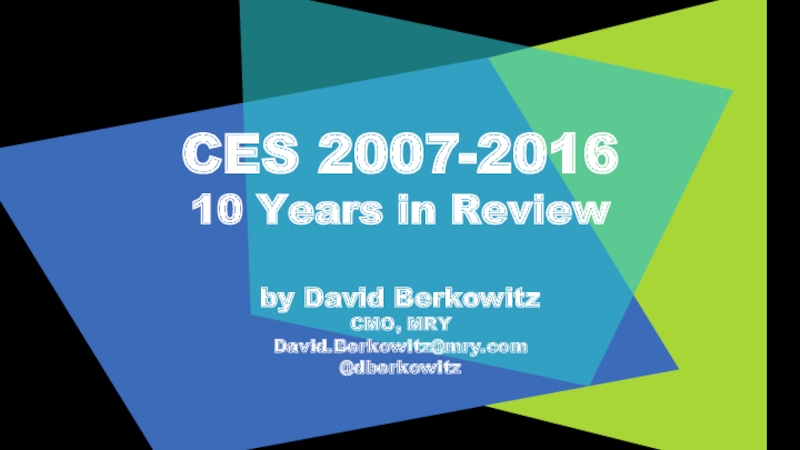
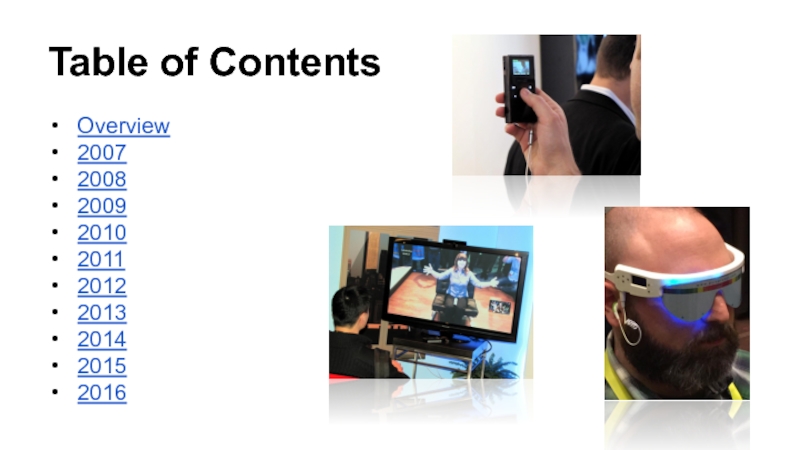
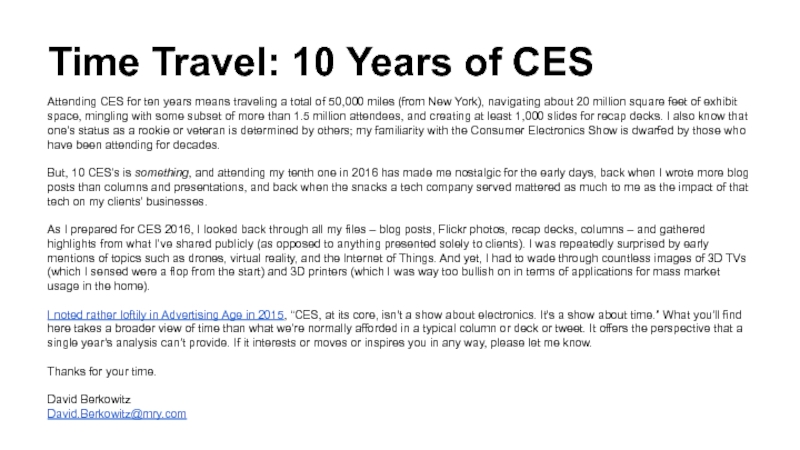
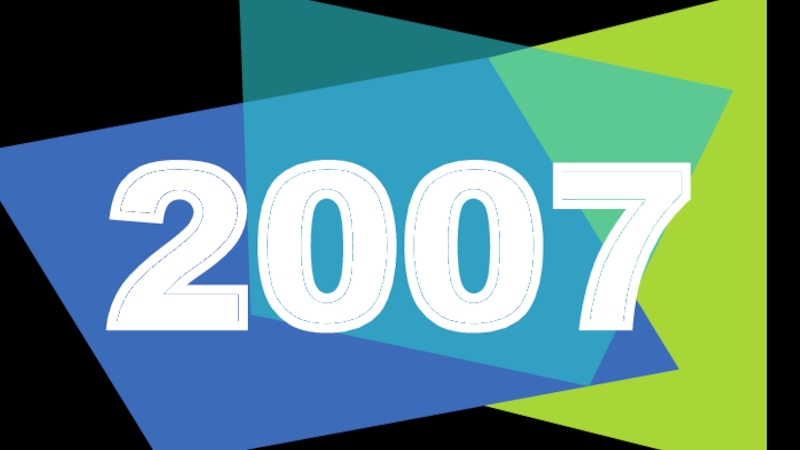
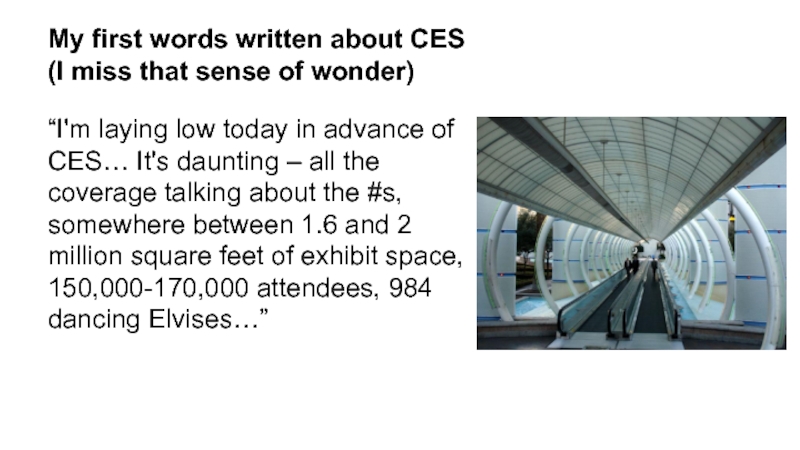
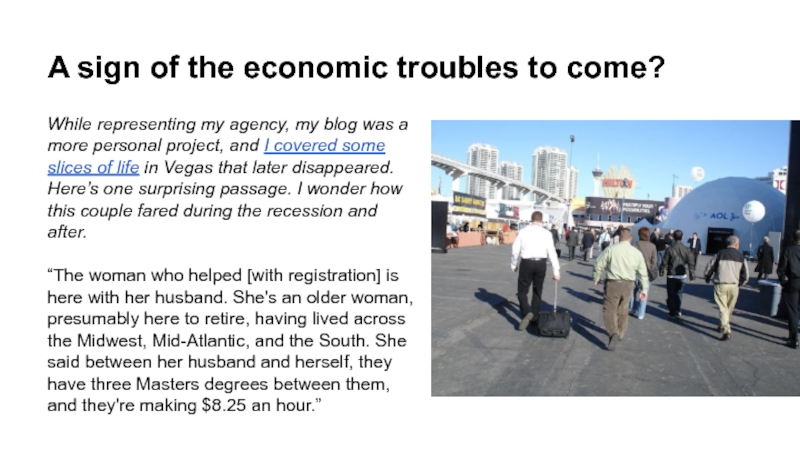
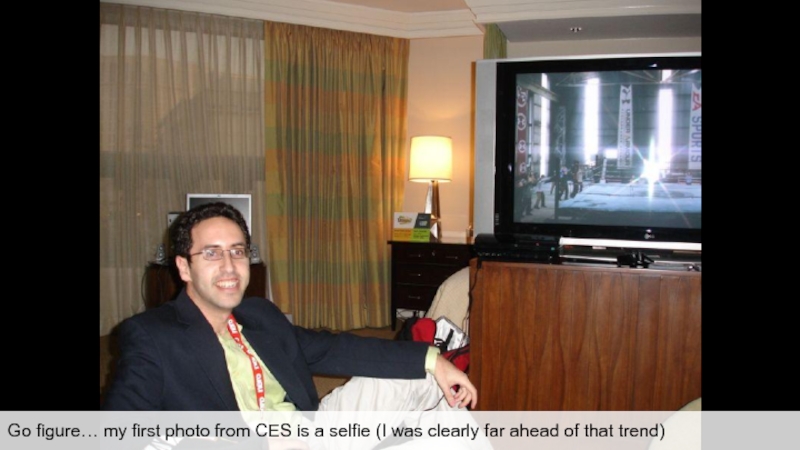
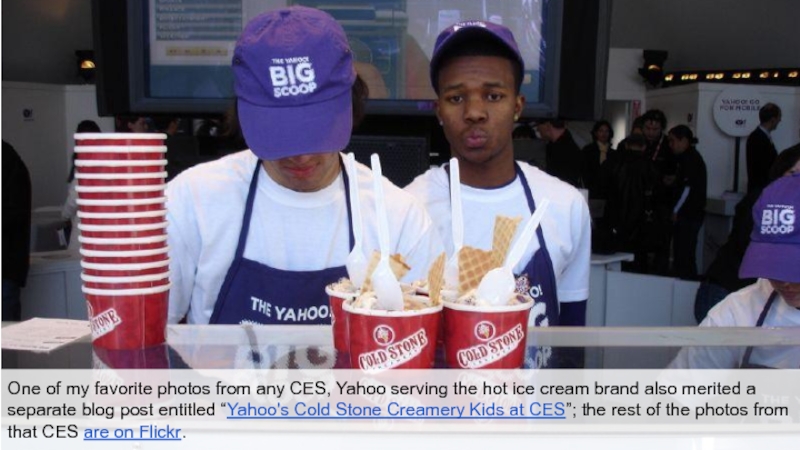
![“[I’m] blogging away with the Dell blogger, and people from Minnesota, and, well, lots of](/img/tmb/1/98117/8e923858dffc044e78d3f4f35197392f-800x.jpg)
